
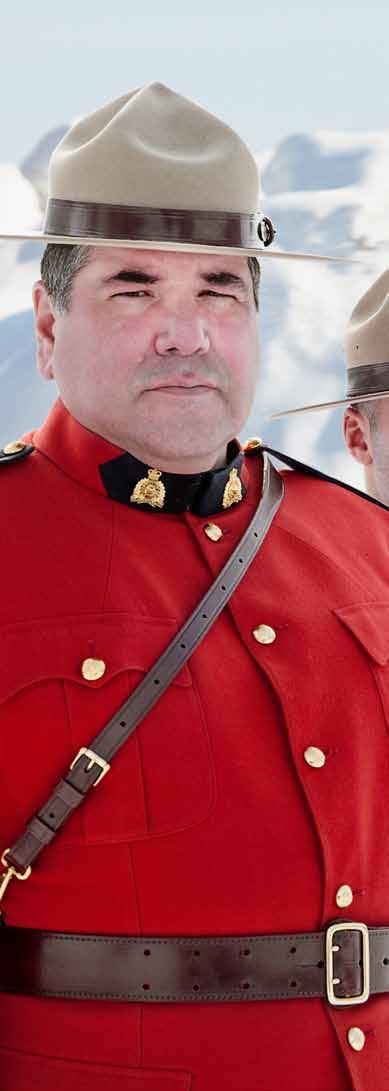
Colouring the Canvas RCMP Wayne Norris Receives the Rank of Staff Sergeant Getting it Right Inuvialuit Make Their Mark at Stokes Point Hockey Heroes Hardworking, Courageous, and Proud no 30 spring 2011 $4 something new to hear about www.tusaayaksat.com
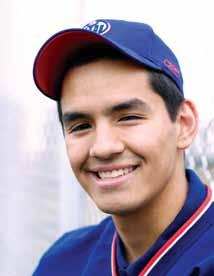

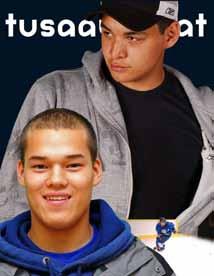


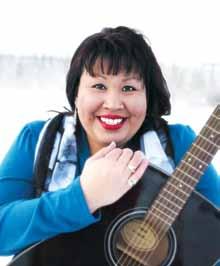
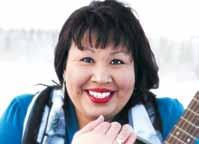
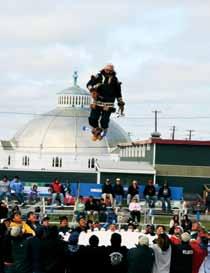


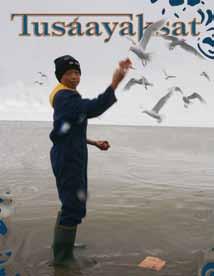









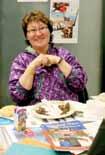

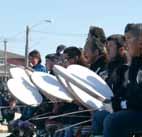


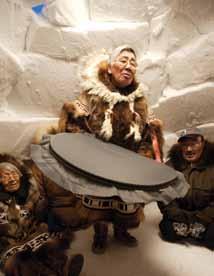
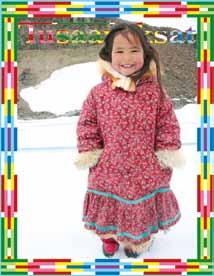
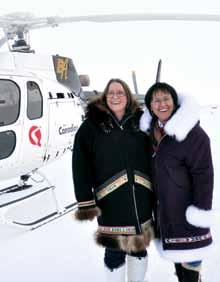
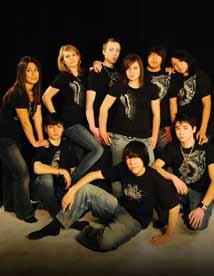
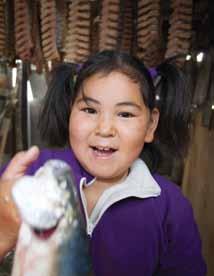
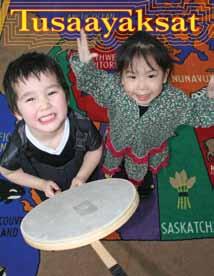
Olympic Flame Lights up i nuvik Building Healthiercommunities through heaLthy Foods north museums and mukluks: a trip to the smithsonian volume 22 number 9 winter 2010 $4 something new to hear about Volume 22 Number 5 Inuvialuit News + Culture SOURCE 177 MOU SignEd REMEMbERing billy day nEw diRECtiOn FOR iCS Norther N h Getsockey competitive WINTER 2008 $4.00 something new to hear about Volume 20 Number 6 November/December 2006 $2.50 Emma Dick "It's Good to Wake Up in the Bush!" Christmas Greetings from the ISR What do we want? Safe Homes! Iqalukpik Jamboree Margaret Lennie Inuvialuktun Writing System CN Rail Memories Kendyce Cockney "John John" Stuart & The Tuk Youth Center The Bomber Pages! Children’s Story & Contest Inside! Celebrating the 22nd annual gnaF Models Walking the Runway and Inspiring By Maung Tin Youth aiming high, dreaming big 2010 National Inuit Youth Summit By JaMie BasTedo n 28 fall 2010 $4 something new to hear about www.tusaayaksat.com Inuvik Community is a place to grow greenhouse des of solitude life returns tion l entre for st present & future Speak OF H jO n 29 winter 2011 $4 something new to hear about Singe SO Leanne gOOS Tusaayaksat_Winter_2011-02_r4.indd 1 Tusaaya∂sat volume 22 number 8 fall 2009 $4 something new to hear about Tusaayaksat Volume 22 Number 3 SUMMER 2008 $4.00 Inuvialuit News + Culture Tusaayaksat DREAM BIG! Kyle Kuptana National Aboriginal Role Model ISR Graduates! Governor General Visits Inuvik + Tuk Climate Change discussion on the Amundsen Kyle Kuptana something new to hear about Volume 20 Number 5 September/October 2006 $2.50 Beaufort Delta Residential School Reunion Mary Simon's Vision for Inuit Great Northern Arts Fest Jordin Tootoo visits Edmonton Jacob Archie on Trapping New Legislation for Tuktoyaktuk Hunters Tony Alanak to teach Fiddling Cindy Voudrach + Confidence Lanita Thrasher Flies High Top of the World Film Festival Graduation Time Grads of 2010 Language Conference English is a Tsunami volume 22 number 11 summer 2010 $4 something new to hear about summer fesTiviTies Inuvialuit Day and Aboriginal Day tusaayaksat volume 22 number 7 summer 2009 $4 jumpingscienceinto & tradition SHSS STUDENTS TAKE OVER IVVAVIK MAD TRAPPER MOVIE PREMIERE NATIONAL ABORIGINAL DAY + inuvialuit news + culture CelebrateTradition! Volume 22 Number 2 SPRING 2008 $4.00 Inuvialuit News + Culture Tusaayaksat Ulukhaktok drum dance reunion Sachs Harbour muskox harvest Nellie’s commitment IRC Hockey Cup highlights Good news for Ulukhaktok Artists something new to hear about Volume 20 Number 4 July/August 2006 $2.50 NELLIE ON TRADITION & CHANGE REINDEER UPDATE DRIMES TRADITIONAL ARTS INUVIALUIT DAY YOUTH RAP TO BUTT OUT JAMBOREE IN TUK, AKLAVIK & ULUKHAKTOK PETROLEUM SHOW & CLASS OF 2006 GRADUATION! HealtH Minister Visits the ISR elder story: Roy ‘Sugloo’ Ipana real. inspiring. Parks Canada’s Inuvialuit Team volume 22 number 10 spring 2010 $4 something new to hear about Volume 22 Number 6 Inuvialuit News + Culture SPRING 2009 $4.00 TURTLE CONCEPTS INUVIK YOUTH BUILD CONFIDENCE LEADING THE WAY WITH INUVIALUKTUN IRC HOCKEY CHAMPS + + Tusaayaksat Volume 22 Number 4 FALL 2008 $4.00 Inuvialuit News + Culture Tusaayaksat Whitefish Station GROWING UP in Paulatuk INUIT HEALTH SURVEY Tuktoyaktuk Graduates! Drum Dancing Gains MOMENTUM Celebrate Life! Celebrate Life! something new to hear about Volume 20 Number 3 May/June 2006 $2.50 MUSKRAT JAMBOREE 2006 AGNES FELIX LOVE POINTERS SELF-GOVERNMENT YOUNG MUSKRAT TRAPPER REPORTS KURT WAINMAN THE GREAT NORTHERN CIRCUS MAKTAK STIR-FRY IRYC PICS! AWG WINNERS HAPPY BIRTHDAY EMMA DICK! & Lots More!
L etter F r OM the e DI t O r I n C h I e F
t he C O ur A ge OF A C OMM un I ty
By Colleen Patterson
F A tty Leg S : A t rue St O ry
By s hafia Usman
g e O rg I n A ’ S Mu SI ng S O n e qu ALI ty
By s hafia Usman
n utr I t IO n nO rth
By
m aia l e P age
Pr OFIL e: B A r BA r A Me MO g A n A A n D
Ch A r L e S g ru B en
54th Annu AL Mu S kr A t J AMBO ree
By s hafia Usman
Pr OFIL e: n e LLI e Arey A n D J OA nne Og I n A
eLD er St O ry: A Le SSO n O n
Le AD er S h IP
t ranslated B y a l B ert e lias
10th Annu AL gWIC h’ I n Cu P
tO urn AM ent
Let t here Be Art: Art Center
r e OP en S I n uL ukh A kt O k
By Karen Corneli U s
Cu L ture O n C AM er A
By l ynn f easey
Inuv I k F I gure Sk A t I ng C L u B
C A rn I v AL
43r D Annu AL tOP OF the W O r LD
Sk I L OPP et
Tusaaya∂sat
N o. 30 SPRING 2011
Our goal: to celebrate and showcase the voices of Inuvialuit across Canada, bringing you the best coverage of our news, vibrant culture, and perspectives.
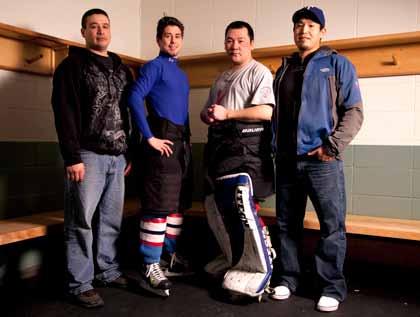
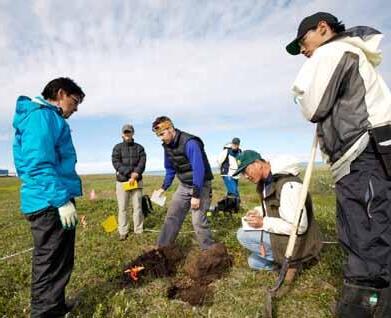
On the C O ver rCMP officers: Wayne norris, Andrew Ancoin, Adam Wood and Mike Peters in red Serge.



Contents
Colouring the Canvas RCMP Wayne Norris Receives the Rank of Staff Sergeant Getting it Right Inuvialuit Make Their Mark at Stokes Point Hockey Heroes Hardworking, Courageous, and Proud 30 spring 2011 $4 www.tusaayaksat.com Tusaayaksat_Spring_2011-05.indd g ett I ng I t rI ght i n U vial U it m a K e t heir m ar K a t s to K es Point By Jamie Bastedo 8 32 PHOTO: Eric H Z H ang PHOTO: Davi D S T uar T PHOTO: cP li SS a Par E PHOTO: Eric H Z H ang 16 S/Sgt W A yne nO rr IS r eturn S t O Inuv I k I n Fu LL P L u M e Prime m inister s te P hen h ar P er and Wayne n orris (2007) By s hafia Usman Our hOC key h er O e S ( l eft to r ight) Corey Wainman, t homas a nthony, Jason n asogal U a K , m i CK ey iP ana By s hafia Usman 5 4 6 12 14 20 22 26 28 42 44 46 48 49
Letter from the

Editor-in-Chief
In his song Wavin’ Flag singer Keinan Warsame sings, “when I get older I will be stronger, they call me freedom, just like a waving flag”. These words are simple yet extraordinarily powerful. They inspire hope and resilience. As we work towards building a hopeful future, we have the freedom and choice to challenge our abilities by looking at different avenues where we can succeed. This rings even truer for the emerging youth that will shape our future. How do we, as their guides, help them attain direction and balance? We, as a society, have to strengthen and build our children’s confidence; only then will there be growth. With growth
will come strength, with strength will come courage, with courage will come humility, and with humility, we can attain self-respect. This issue of Tusaayaksat signifies words of hope and strength from within the community that seeks to encourage us to achieve our goals by being passionate and keeping to the right path.
tusaayaksat is Inuvialuktun for “something new to hear about.”
Published quarterly by inuvialuit Communications s ociety at 292 mackenzie drive, inuvik, n W territories, Canada. For advertising and subscription inquiries: please email us at ics@northwestel.net or call (867) 777-2320
Contributors
Jami E Ba STEDO, k ar E n cO rn E liu S, a l BE r T Elia S, lynn fE a SE y, m aia lEPag E , cO ll EE n PaTTE r SO n
Contributing Photographers Jan ET B O xw E ll, f r ED c aT rO ll, k ar E n cO rn E liu S, lynn fE a SE y, i nuvialui T cO mmunicaT i O n S S O ci ET y, i nuvialui T c ulT ural rESO urc ES cE n T r E , Davi D S T uar T, m aung Tin, S H afia uS man, Eric Z H ang
Special t hanks
k aTH l EE n a ll E n, c aTH y cO ckn E y, a l BE r T Elia S, D E l O r ES Harl E y, vE rO nica k a SOO k, Duan E Smi TH, gE rry k i SO un, i nuvik rcm P D ETac H m E n T
Designer Davi D l im O Production a uku ST i mED ia D ES ign S T u D i O
ICS Board of Directors President J E rO m E gO r DO n (Aklavik)
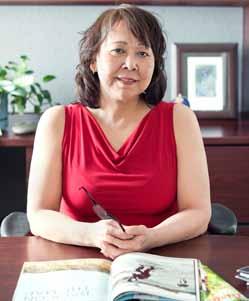
v ice President D O nna kEO gak (Sachs harbour) treasurer D EBB i r a DD i ( tuktoyaktuk)
Directors D E l O r ES Harl E y (Inuvik) m illi E T H ra SHE r (Paulatuk) m argar ET k anay O k ( ulukhaktok)
4 Tusaaya∂sat SPRING 2011
Topsy cockney
Publisher i nuvialui T cO mmunicaT i O n S S O ci ET y editor in Chief T OPS y cO ckn E y Managing editor m aung Tin Writer Photographer S H afia uS man
PHOTO:
Eric Z H ang
The Courage of a Community
By Colleen Patterson
It is spring in Inuvik, the days are getting longer, the ice roads are thawing and many of the community’s residential school survivors are preparing to share their truths with the Truth and Reconciliation Commission for the first time.

From June 28 to July 1, 2011, survivors of residential schools in the North will gather in and around the Midnight Sun Complex and Jim Koe Park to finally speak about what happened to them as children.
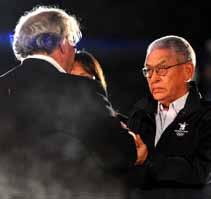
“Today many aboriginal people are still too timid to speak out about the pain and suffering experienced in the government-run residential schools, but that has to change,” says Inuvialuk Elder John Banksland.
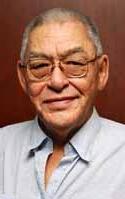
John is a member of the TRC Indian Residential School Survivor Committee and he knows firsthand that it takes a lot of courage for people to tell a story they have been keeping inside most of their lives. John was born in Ulukhaktok and spent 15 years in residential schools. Eleven of these years were spent in Aklavik and four in Yellowknife.
“Residential schools created a lot of pain and suffering for survivors and their families. People have been carrying around this hurt their entire lives. The TRC Northern National Event will be a chance for them to get it off their chests and start healing.”
The TRC is using the Seven Sacred Teachings as themes for their events. For Inuvik, the TRC Survivor Committee has selected Courage. John explains that even though these teachings did not originate in the
North, they are still relevant.
“It is time for us to be strong enough to talk about our experiences and that takes courage. Many survivors have passed on without the opportunity to share what happened and how it impacted them. For the first time, the TRC is giving us that chance. Those of us who are ready to talk about it are rising up and speaking. It is helping us to realize that we don’t have to keep living this way.”
The Northern National Event provides a forum for the TRC to receive statements related to Indian Residential School (IRS) experiences. In June, hundreds of survivors will gather in Inuvik to participate in Traditional Ceremonies and Sharing Circles with the TRC Commissioners and Survivor Committee.
The Event will also serve to educate and enrich the broader Canadian public on the history of IRS schools and provide opportunities for gestures of Reconciliation.
The TRC anticipates not only survivors, but many other members of the general public will attend. Through this event, the courage and resilience of residential school survivors and their families will be shared with Canadians from coast to coast to coast.∞
t he opening ceremonies will begin on June 28th with the lighting of the Sacred Fire with ashes from the Sacred Fire that burned during the Winnipeg national event last year. If you are interested in attending or would like to volunteer please visit trc. ca for more information or contact Marie-Anick elie at marieanick.elie@trc.ca or 678-8608.
residential School students at Aklavik
trC Survivor Committee member John Banksland
trC Survivor Committee members John Banksland accepting the responsibility of bringing the ashes from Sacred Fire at the Winnipeg national e vent to Inuvik in June 2010
PHOTO S : f r ED c a TT r O ll. cO ur TES y O f T rc
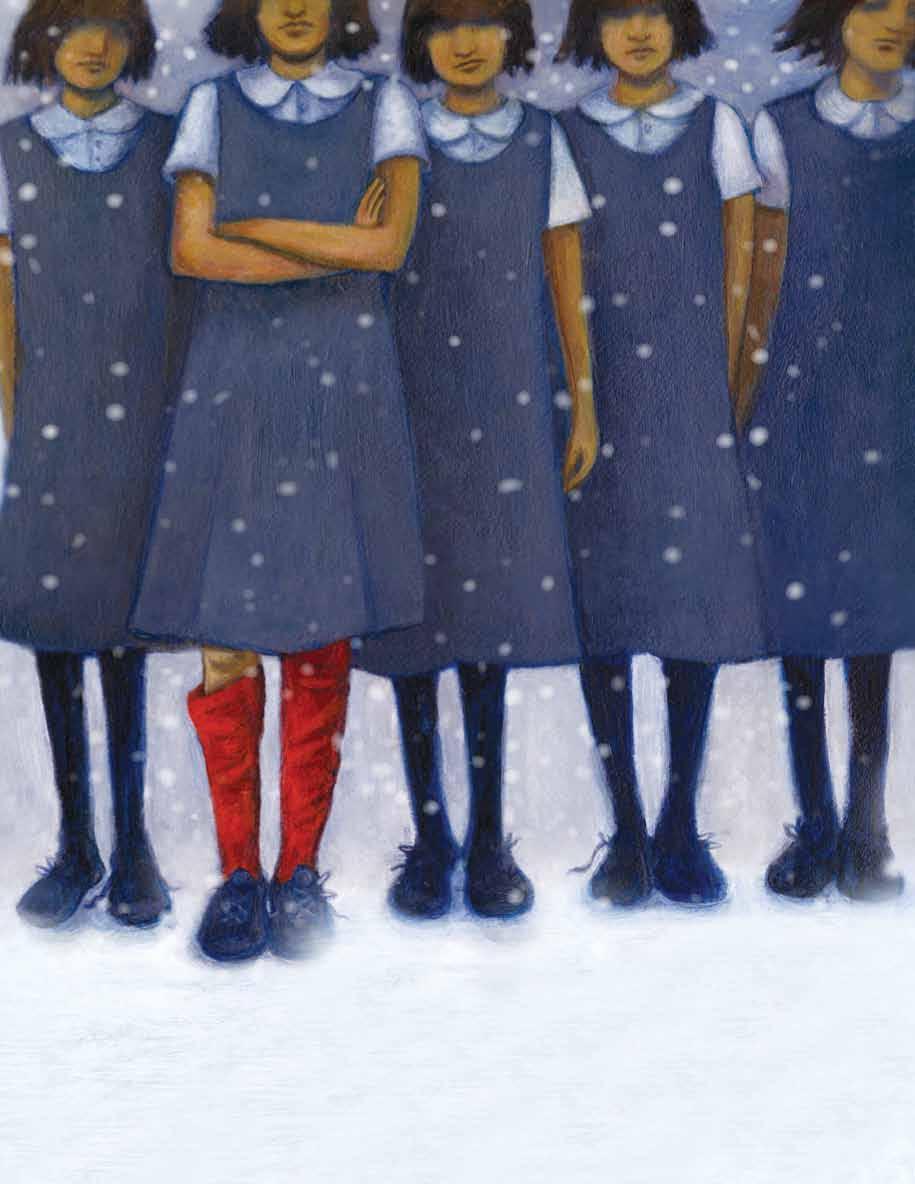
6 Tusaaya∂sat SPRING 2011
Book review
By Shafia u sman
Fatty Legs: A True Story
Fatty Legs is both a children’s book and a memoir of Margaret Pokiak-Fentons’ true experiences at Aklavik’s residential school. When Margaret arrives at the school, Raven – the hooked-nose nun –consistently humiliates the strong-spirited Margaret. Margaret’s real turmoil began when Raven forces Margaret to wear a pair of red stockings, while all the other girls wore gray stockings. Just like that, Margaret’s classmates began to tease her and call her fatty legs.
At the beginning of the book we are introduced to Margaret’s picturesque arctic childhood. In the 1940s, Margaret grew up on Banks Island where her father was a hunter-trapper. At a young age, Margaret traveled along the Mackenzie River with her family to Aklavik. This was where she first saw the dark cloaked nuns and she was aware that they “held the key to the greatest of the outsiders’ mysteries – reading”.
Margaret pleads with her father to send her to school so that she could learn how to read. Margaret’s father warns her that she will risk losing the knowledge of hunting, curing meat, making embroidered parkas and her own songs and dances if she goes to the residential school. But the innocent and feisty Margaret kept pleading with her dad to let her study. When Margaret was eight years old her parents makes the difficult decision to send their daughter to the residential school.
When Margaret arrives at the school she tolerates a lot of hardship; her long braids are cut off, she is scolded for speaking her own language, she suffers from homesickness, and she is assigned to do difficult and unpleasant chores. But she remains determined to learn how to read.

What Margaret cannot tolerate is how Raven
consistently taunts and degrades her in front of the other students. Raven’s unrelenting humiliation makes Margaret determined to show Raven “the spirit of us Inuvialuit.” The rest of the book reveals a series of Margaret’s small acts of resistance against the unjust Raven until, finally, one day Margaret crafts a way to liberate herself from the red stockings.
Margaret Pokiak-Fenton co-wrote the book with her daughter-in-law Christy Jordan-Fenton. Their decision to turn Margaret’s story into a children’s book makes Fatty Legs a unique account of the residential school experience. Also, Liz Amini-Holmes, who illustrated Fatty Legs, captures Margaret’s emotional turmoil in her dramatic artwork.
Liz Amini-Holmes’ poignant illustrations will pull at the reader’s heart. Amini-Holmes explained to me that Christy’s “darkly poetic” writing nourished her own artwork. “Thankfully there were so many different emotional beats in the story,” remarked AminiHolmes, “I had room to convey evocative images of Margaret’s fear, loneliness and determination, and could express a more complex and bittersweet experience.”
The writing and the artwork take us from a young girl’s innocent desire to read, through her painful homesickness and ultimately her courage to stand up to her oppressor, with both humor and heartbreak.
When I opened the book I expected a story rife with pain and lament over a childhood lost to residential school. But what I found was a story of Margaret’s triumph. Fatty Legs offers an invaluable lesson for children humiliated by their oppressor or adults who hold onto the grief from a painful past; which is that each of us can find the strength within ourselves to stand up to injustice and restore our sense of dignity and self-worth.∞
ANK-FL-Design-100315.indd 47 4/6/10 10:02 AM SPRING 2011 Tusaaya∂sat 7
a book by Christy Jordan-Fenton and Margaret Pokiak-Fenton illustrations by Liz Amini- h olmes
RiGht Stoke S Point
By Jamie Bastedo
Did you ever see that crazy cold war movie, Dr. Strangelove or How I Learned to Stop Worrying and Love the Bomb? It was definitely a product of its time, the good old days of nuclear megadeath, missile envy, and “mutually assured destruction” or MAD – the military theory that neither the U.S.A. or Soviet Union would dare launch the first H-bomb for fear of triggering a massive retaliatory attack on themselves. The idea was that both attacker and defender would be wiped off the map.
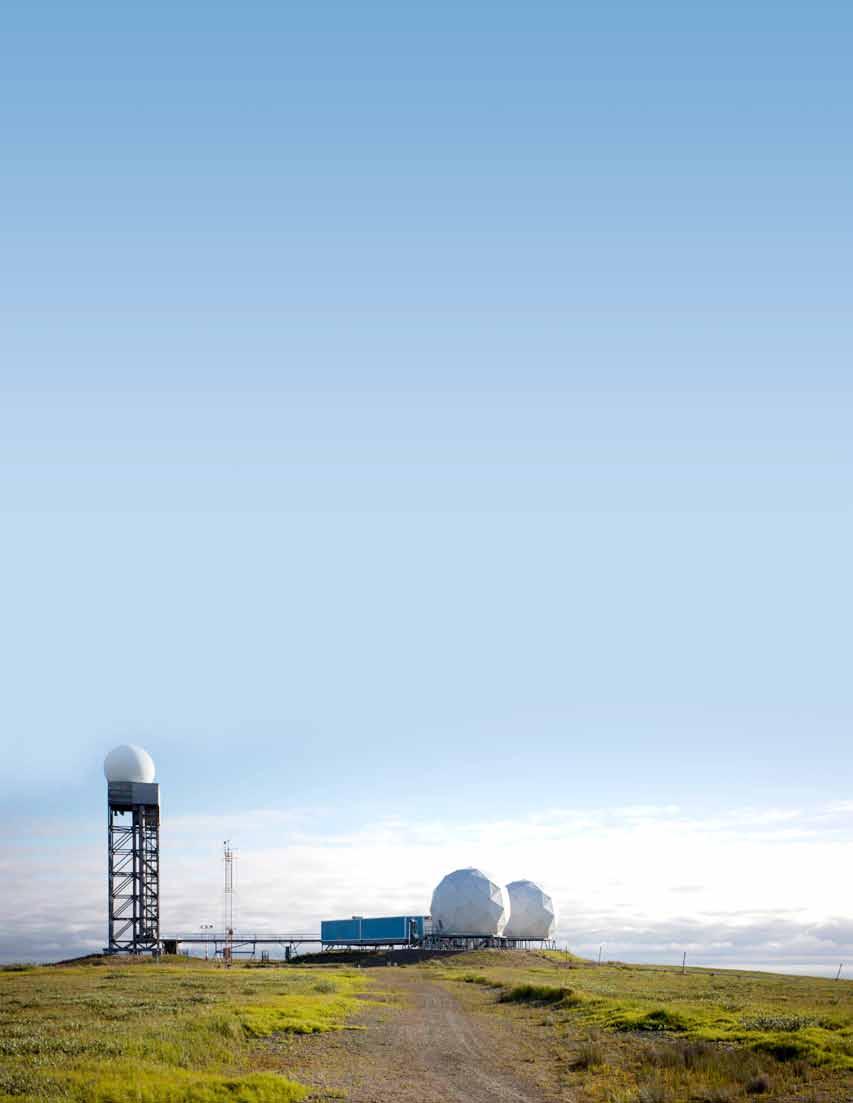
Gettin G i t
Inuv I alu I t Make t he I r Mark a t
Director Stanley Kubrick didn’t originally want Dr. Strangelove to be funny. But the more he learned about cold war practices, the more they seemed absolutely ridiculous. The result was a side-splitting nightmare comedy that was nominated for four Academy Awards.
There’s nothing funny however about what happened at Stokes Point, another product of cold war craziness. Back in the late 1950s, when many Americans were building bomb shelters in their backyards, U.S. military strategists took aim at Stokes Point to construct one of their many Distant Early Warning or DEW Line stations, meant to warn us of looming nuclear destruction – mutually assured, of course. A military radar base and air strip were promptly carved into the sands of Stokes Point, or “BAR-B” as it was called on U.S. Air Force maps.
Completed in just a few months and ultimately stretching from Alaska to Greenland, the DEW Line project was hailed as a unique triumph of scientific design and logistical planning.
But, in the case of Stokes Point, did those military masterminds care to ask the local Inuvialuit if they had any concerns about building on this site? Were the Inuvialuit offered economic benefits from construction at Stokes Point or other associated spinoffs?

Were they informed that construction wastes and other toxic materials had been bulldozed straight into the sea? In short, were the Inuvialuit involved in this grand military project in any way shape or form?

Basically, no.
Did things improve when Stokes Point was later used as an exploration camp during the Beaufort Sea oil boom of the early 1980s?
Not really.
But, thank goodness, times have changed.
More than sixty years after the American flag was raised at Stokes Point, the Inuvialuit have made it very clear who’s in charge of that precious piece of coastline.
Why precious?
Unknown to military planners bunkered down in Colorado or oil and gas executives in downtown Calgary was the fact that the sweeping sand beaches and protected coves of Stokes Point have, for generations, made it an important Inuvialuit site for harvesting wildlife, finding protection when boating along the coast, or just relaxing and picking berries. It was these kinds of traditional values that promoted the site’s inclusion in Ivvavik National Park, established in 1984 as a result of the Inuvialuit Final Agreement.
The people of Aklavik are among the most frequent users of Stokes Point. They were the ones who, back »
PHOTO S : m aung Tin & Davi D S T uar T
Aklavik drummers and dancers.
SPRING 2011 Tusaaya∂sat 9
e velyn Storr
in 2004, got the ball rolling on properly cleaning up the place after decades of abuse and neglect by southern interests.
“A lot of people that use that area felt that it wasn’t safe,” says Evelyn Storr, Aklavik’s Senior Administrator Officer. “They were really concerned because of the amount of waste that was there. If it’s not removed it’s going to effect the berries and the caribou and everything eating the berries, anything that is close to the ground. That was the biggest concern. On a few field trips, I saw big steel items like old vehicles sticking out. There was concern too about a few cabins built from plywood and stuff off the Dew-Line site which of course was painted and had all the contaminants on it. People had concerns because they felt that maybe in the past some elders might have gotten sick by staying in the cabins and breathing that stuff in.”
Over the years, no one had done a detailed study of contaminants left by past activities and any cleanup efforts at Stokes Point had been piecemeal at best. The community of Aklavik joined forces with Nellie Cournoyea, Chair of the Invuvialuit Regional Corporation (IRC), and, after a series of back-and-forth letters, finally convinced Parks Canada that something had to be done.
Ifan Thomas, Parks Canada superintendent for the western Arctic says that, “We ultimately agreed with them that Stokes Point needed to be cleaned up, both from a human safety perspective but also because it’s part of a national park and we have a mandate to make sure that the ecological integrity of the site is maintained.”
This agreement led to the formation of the Stokes Point Steering Committee. Inuvialuit concerns were voiced by members from the Aklavik Community Corporation, Aklavik Hunters and Trappers Committee, the Wildlife Management Advisory Council, and IRC. Federal interests were represented by members from Parks Canada and the Department of National Defence.
“The steering committee was established to really look for the concerns of the community, the concerns of the Inuvialuit people that use the Stokes area,” says Evelyn Storr, “and to ensure that their needs and concerns were addressed.”


Struck in 2005, the committee’s overall job was to provide guidance throughout the site investigation and advise on what should – and should not – be in the cleanup plan.
“We worked with the community on how we would do the cleanup,” Ifan Thomas says. “We determined which things we would remove and which were better to leave in place, because digging them up would cause more damage than leaving them. Then there were also some cabins. We wanted to make sure if we were pulling materials from the cabins that they were actually contaminated. We were making sure that the cabins that are still used continue to stand.”
The road from community concerns to cleanup took a long time, probably longer than anyone on the Steering Committee expected.
“We didn’t rush through the process,” says Storr. “There were different stages and so much testing. There were still concerns, testing for this and that, and
10 Tusaaya∂sat SPRING 2011
nelson Perry
Sydney McLeod
results were brought back to us to ensure that everything was done properly. It took time.”
“It took a little while to get the funding lined up,” explains Nelson Perry, an ecosystem scientist with Parks Canada, “because it was a six million dollar project. Once we knew we were going to have funding each year, the steering committee was created and full site investigations started in the summers of 2006 and 2007. We did a complete site investigation, sampling water, vegetation, and wildlife to determine what contaminants were there and also what type of physical debris needed to be cleaned up.”
Besides securing funding and doing all the field studies, another step that took time was to maximize the chances of Inuvialuit contractors getting economic benefits related to any site work.

“Parks Canada really tried to make sure that most of the economic benefits went to the Inuvialuit Settlement region,” Perry explains. “We also put a specific focus on Aklavik to ensure that all contract opportunities, sub-contracts, and direct employment were maximized to the extent possible. We set up a special contract process that was open tender but the company bidding got extra points if they demonstrated they were offering maximum opportunities to Aklavik and to the region as a whole. We feel that we succeeded on the economic benefit side.”
Once the money and the field studies and the contracts were all in hand, the actual cleanup job got done in just three and a half weeks.

Looking back on the entire process Parks Superintendent Ifan Thomas admits it took a lot of time.
“But,” he says, “I think that the time it took reflects the fact that we're working in probably one of the most isolated and most difficult places in the world to work. It’s the arctic, we're way above the Arctic Circle, we're on the Beaufort Sea, there aren't any roads, you’ve got to use incredible measures to get to the site. If you want to do a cleanup you’ve got to bring in all sorts of equipment. That just takes patience and time. And you need to plan these things out, you need to rely on local knowledge to make sure you're thinking about all the implications of one approach over another. So that’s the message I'd share with others – that we really benefited from working closely with the community throughout the process and allowing the community, in a meaningful way, to influence the process.”
Are the people of Aklavik happy with the outcome? Well, at last January’s official Stokes Point Cleanup party held in the community, the mood was pretty darned positive.
Who better than Aklavik’s own Evelyn Storr to answer that question? “The actual cleanup was very well organized, I must say. We went down there on a day trip just to look at the cleanup and I was quite impressed. They had a good crew and everything went smoothly. I think the community might have some questions in the back of their minds, but at least they have more of a comfort zone now when they go down there. They know how much stuff was brought out and that the approach was the best. People will continue to use that area. It’s just right along the coast, you can’t miss it. It will give them just a better feeling of going in there and using it like how they used to.”∞
PHOTO S : m aung Tin & Davi D S T uar T SPRING 2011 Tusaaya∂sat 11
Douglas Irish-Blake Stokes before the cleanup.
Geor Gina’s MusinGs on e quality
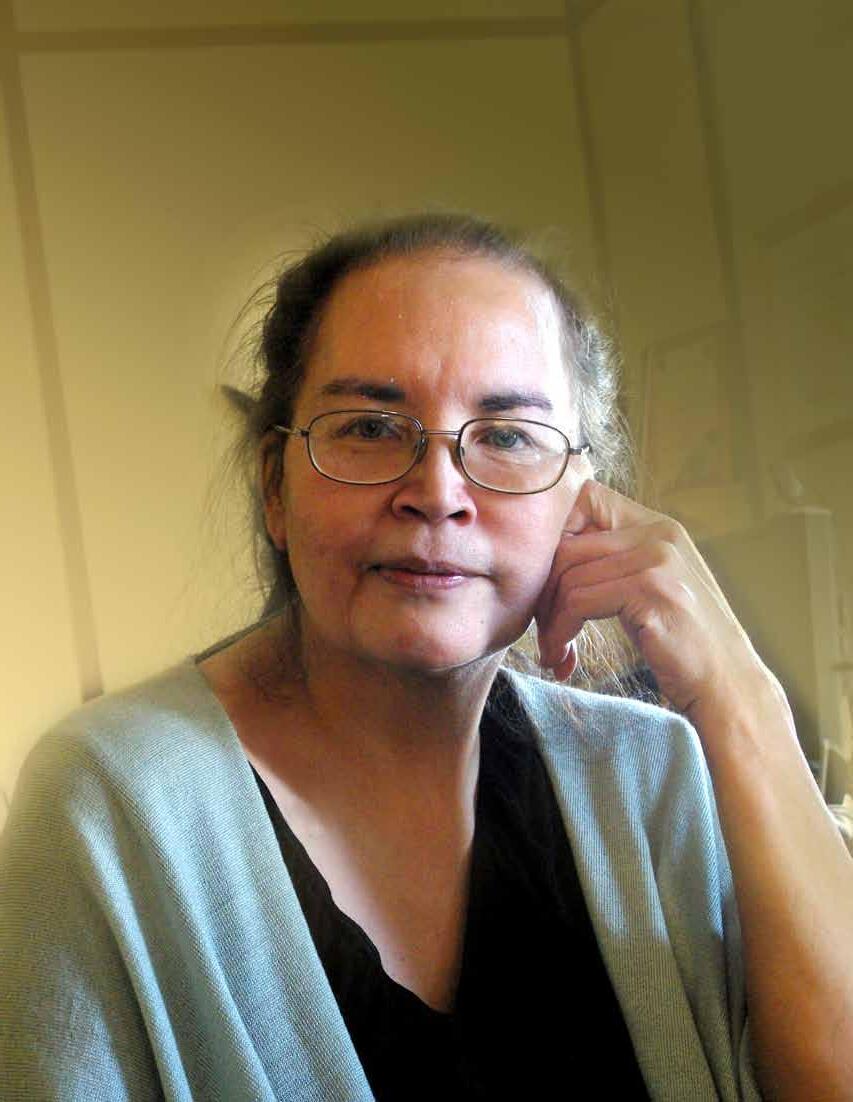 By shafia usman
georgina Jacobson Masuzumi at her home in tuktoyaktuk
PHOTO: m aung Tin
By shafia usman
georgina Jacobson Masuzumi at her home in tuktoyaktuk
PHOTO: m aung Tin
Georgina Jacobson Masuzumi is a very remarkable woman. She has fearless green eyes and a forceful personality. “I made my own way in the community. The elders gave me permission to do whatever I did,” said Georgina. “I guess I’m a self made woman with a voice. Natural curiosity.”
The strong-willed Georgina went back to college at the age of 38, completed a diploma in recreation coordinating at 40, and has hosted Canada’s Governor General Michaëlle Jean for lunch.
Georgina is exceptionally devoted to her community and, with the help of her husband, she is currently raising nine foster children. “The reason that I’m taking in the foster children is because I don’t want to see our own children leave the ISR,” said Georgina. “I want to raise them in their own community where the parents can have access to them.”
It is no wonder that the Minister from Health and Social Services recently appointed Georgina to serve as a director on Status of Women Council. As director, Georgina has a wide range of responsibilities, which include providing advice to the government, engaging in research activities, and advocating on behalf of women, just to name a few.
Georgina was drawn to this work right from the beginning. “The vision of the status of women is equality for women in all areas… A society which respects and includes the diverse experiences and perspectives of women,” explained Georgina. “That was what really grabbed me because all my life I’ve been doing what I do as a woman and finding roadblocks which are put in front of me which I had to knock down or walk through to just be equal.”
For Georgina the most pressing gender issue in the ISR is equality between men and women. “Equality is really important because life is so hard up here – man or woman, doesn’t matter what their education is – it is so hard to make a living,” said Georgina.
Georgina’s musings on equality are poetic. Equality is “to give another human being the chance to speak, talk, and be themselves. I’d like to see that without having any violence done towards them and without having somebody saying ‘oh, you shouldn’t be doing that’,” states Georgina.
“I think that any woman who does whatever she wants or chases her dream or her goals realized is equality. If she can stand beside her own people in her own community and they all say ‘oh that’s okay. She’s opinionated anyway. She’s doing the right thing to make a living’ -- that’s all I want to hear in the ISR. Give everybody a chance to survive,” Georgina continued. “There isn’t enough of that in our community sometimes. Sometimes people don’t feel empowered to give another person that right to be equal.”
Georgina advocates that education and participation in community decision-making is a practical way to overcome obstacles to gender equality or women’s empowerment in the ISR. Georgina urges the young women in the ISR to keep on reading and keep on dreaming. “Sometimes life tends to knock you down,” Georgina
said as she took another sip of her coffee. “Pick yourself up, dust yourself off and get on with it because no one else is going to do it for you. Get involved in the community, in politics. Try some different kinds of occupations for a little while.”
Georgina knows first hand that there are struggles and obstacles in life but she also knows the importance of moving on. “How do you let go of the garbage you picked up in your past? You can’t dwell in the past and think you’re going to have a future. The longer you dwell on something you did or the longer you’re putting yourself down…. You just have to get up and move along and say its okay,” continued Georgina. “You have to forgive yourself for a lot of things you’ve done. You have to have lots of forgiveness and do things with kindness.”
Georgina also points out that women have a lot to celebrate in the ISR. She says many of our women are keepers of our traditional knowledge. We should also celebrate our women in nontraditional occupations and support our women in politics. “We have a lot of women like that in the ISR,” said Georgina proudly. She listed off some of her role models such as Nellie Cournoyea (“I watched how hard she worked to get us our land claims”); Bertha Allen, who started the Native Women’s Association; Leena Wolki from Sachs, who is opinionated and accomplished in the trade of arts and crafts; Mabel Ruben from Paulatuk who raised ten children with her husband. “These women are very powerful women,” she emphasized.
On March 7th the Status of Women Council of the Northwest Territories hosted a two day conference entitled “Celebrating Northern Women: A Century of Achievement” in Yellowknife. The conference was organized to celebrate International Women’s Day and to promote positive and healthy changes within Northern communities. As a director on the Status of Women Council, Georgina Jacobson Masuzumi represented the Beaufort Delta area at the conference.
The “Celebrating Northern Women” conference started with annual Wise Woman’s Awards to recognize women who stand out in their communities as role models and for their hard work in advocating on behalf of women. The ISR’s very own Ann Kasook received a Wise Woman Award for her work at a transitional center in Inuvik, which made Georgina very proud.
Georgina Jacobson Masuzumi is fearless with a firecracker personality; she is indeed a very remarkable woman.∞
SPRING 2011 Tusaaya∂sat 13
Nutrition North
Have you ever walked into a grocery store and gasped at the price of fresh milk? Or nearly fainted when you saw how much a bag of cherries cost? If you answered yes to either of these, then chances are you live in Canada’s great, white and expensive North. Northerners have a different perspective when it comes to buying food. We eat what we can afford, and sometimes that means neglecting proper diets. Nutrition North Canada is looking to correct that with a new subsidy program that took effect April 1st, 2011. The goal of the project is to make nutritious, perishable foods accessible to Canadians living in isolated northern communities.
The new system is similar to the past food subsidy program but this one focuses more on the requirements of the Canadian Food Guide. The new program will feature 2 categories. Category 1 contains foods that are considered to be the healthiest and they will receive the greatest subsidy. Category 2 contains food
like crackers and unsweetened juice, which still have nutritional value, but are not as healthy as the foods in category 1.
Anita Pokiak is a community health representative for Tuktoyaktak and has recently become involved in Nutrition North Canada’s community programs, which focus on teaching healthy eating habits and food preparation. “I’ve been working in the health center for many years,” says Pokiak. “I have a real concern for peoples health and I know we [Nutrition North Canada] do a lot of different kind of promotions but what we promote is eating. Everything we eat does something to our body. If we can learn to eat properly then we will all be healthier people.“
Like most health care professionals, Pokiak has noticed the lack of fresh vegetables and fruits in our diets, and she attributes this to the extremely high cost and limited availability of healthy foods. She is hoping that the programs Nutrition North Canada are providing in the communities will help promote healthy


14 Tusaaya∂sat SPRING 2011
Catherine Mangelana is enjoying baked salmon and sweet potato fries at the nutrition north workshop
By Maia Lepage
eating habits and also get people excited about cooking with new foods.
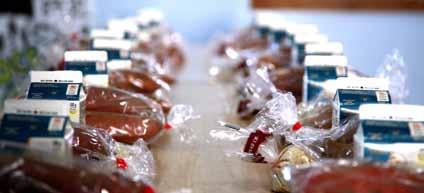

Diana Trang is a nutritionist with the Canada Prenatal Nutrition Program, which provide support to high-risk moms who have babies or who are pregnant and she agrees with Pokiak. “The most important thing is to get the stores to bring in certain products before people can change their eating habits,” says Trang. “I don’t know if it is unique to this particular area. It might be challenges elsewhere as well, but one of the things I find is that its really challenging to get stores to bring in new products because they don’t know if its going to sell.”
“In Canada, most people don’t eat very many beans,” says Trang. “We try to encourage people to have some vegetarian meals because it is better for your health, lower in fat and high in fiber. We try to find recipes that taste good so we can show people that you can have this as a substitute. And its still going to taste good.“
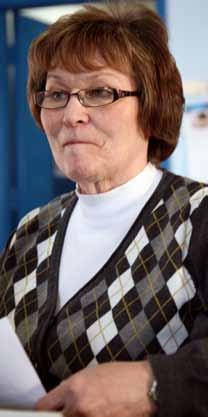

If we take a quick look at beans, we might be surprised at everything this little fruit has to offer. One cup of cooked beans provides approximately nine to thirteen grams of fiber. Soluble fiber can help lower blood cholesterol, which is a common health concern among men 55 years of age or lower, and women 55 years of age or older. Beans are also high in protein, complex carbohydrates, foliate, and iron. A common side effect of beans is the musical effect it has on our gastrointestinal system, and it is also the reason many Canadians shy away from this “musical fruit”.
Nutrition North Canada’s goal is to give us the knowledge to make healthier eating habits and their subsidy program is going to give us the means to make the right choices. Just because we choose to live in the beautiful North doesn’t mean that our diets (and wallets) have to suffer. We can have our North, and eat cherries too.∞
Ingredients for a nutritious recipe
Anita Pokiak
nadine Pingo, invaluable volunteer.
SPRING 2011 Tusaaya∂sat 15
Left row (front to back) Mardy voudrach, Lucy Dillon, Diane nasogaluak, Brenda k imiksana, ella-Jean nogasak, nadine Pingo, Bob Lundrigan r ight row (front to back) eva raddi, e velyn Cockney, Dorothy Loreen, Catherine Mangelana, Anita Pokiak, Winnie Blake
PHOTO
S : m aung Tin
S/Sgt Wayne Norris Returns to Inuvik in Full Plume
By Shafia u sman
After 25 years of service with the RCMP, Wayne Norris received the highest rank an Inuvialuit member has received; the rank of Staff Sergeant.

Norris never intended to be an RCMP officer. In December 1985, he was training at Transport Canada to become a vehicle heavy equipment technician when a conversation with Cst. Frank Carpenter and his son Merle changed the course of his life. “They both kind of talked to me about it and twisted my arm,” said Norris. “They got me interested enough… I guess I probably lacked some confidence back then.” Frank and Merle were just the push that Norris needed. Eight months later Norris was sworn in as a special constable and he has never looked back.
Soon after Norris was promoted to a regular member. “I started my career working my first eight years in Inuvik and Aklavik,” continued Norris, “Then moved to the southern end of the territory with my wife Rhonda and our three children.” Norris has had a colourful career. He was in charge of “G” Division Aboriginal Policing Services before eventually moving
on to Federal Enforcement. There was even a time while in the Federal Enforcement that Norris was responsible for the Prime Minister’s security. Norris has also provided security for the Governor General Michaëlle Jean, Prince Andrew and the Olympic torch while it was in the north. “You know for a young fella coming from Inuvik and to experience some of the things that I’ve done. Is pretty interesting,” Norris said with a smile. “To be able to fly in a Challenger Jet with these people and to travel around with them is just [its an honor].”
“I’ve had all kinds of experiences,” Norris said as he reflected on his 25 years of service. “After 25 years I was getting close to thinking of doing something else, maybe retiring and maybe look at other things. And this opportunity came up for me to come up here as Detachment Commander [in Inuvik]… It kind of rejuvenated me a little bit -- got some wind back in my sails.
16 Tusaaya∂sat SPRING 2011
“To become a staff sergeant in the RCMP you have to have a lot of good experience,” explained Gerry Kisoun, a friend and former RCMP member who served for 25 years himself. “He had approximately thirty RCMP members under his command while looking after the security of the Prime Minister's Trip,” said Kisoun as he highlighted Norris’ extensive leadership skills. “It will be good to have Wayne home for the next number of years,” continued Kisoun, “I got another hunting partner.” Hunting is one of Norris’ favorite pastimes.
Norris knows how fortunate he is to know the area and the great people that live here. “For anyone else that would have come here in my spot they would have had to learn a whole lot about the cultures and the communities…how it ticks,” explained Norris,
“I’ve got that sewn up already because I know my community.”
Norris’ family has been in the North for many years. His father, Fred Norris arrived here at the age of seven with his parents, Adolphus and Christine Norris. They had migrated from Waterways, Alberta to the Mackenzie Delta for what was then a thriving fur industry. “I believe Aklavik was a mecca back then, producing over 100 thousand fur pelts a year,” recalled Norris. All of Fred’s siblings were born and raised in the north.

Norris’ mother Eunice Arey-Norris was originally from this region as well. Her brother, Jimsey Arey, served in the military as a Master Corporal while her other brother, Donald Arey, worked for the RCMP in Aklavik and Hay River. Both of Norris’s brothers, »




SPRING 2011 Tusaaya∂sat 17
Wayne norris with Olympic torch in 1988
S/Sgt. norris with his family during medal ceremonies.
(Left to right) son Jeffrey, twin daughters kelly and Brittney and spouse rhonda
PHOTO: cP l iSS a Par E
Wayne norris with her e xcellency the r ight honourable Michaëlle Jean
Wayne norris at age one wearing his first uniform.
Adolphus and Dino, also served in the RCMP. “So it was kind of a family affair,” said Norris.

On February 1st, 2011, Norris was the first Inuvialuit member to receive the rank of Staff Sergeant.
One could interpret Wayne Norris’ story as a new chapter for Inuvialuit-RCMP relations. Norris sees himself as part of the rich history between Inuvialuit people and the RCMP. Although Norris is aware of the RCMP’s involvement in the residential school experience, he explains that the RCMP has also many other connections with the North. They have had numerous Inuvialuit officers over the years, which have played a positive role in the community. “By far we out number any other aboriginal group in the north for
representation,” said Norris. Norris has fond memories for retired RCMP members such as Cst. Gerry Kisoun, Special Cst. Otto Binder, and Cst. Fred Bennet. “We had our own history of special constables…I guess I could say that probably I’ve achieved the highest rank as a staff sergeant and I feel fortunate that I got the opportunity to do that as well as assured that I had a lot of support prior to that from a lot of other Inuvialuit that have gone before me.”
Norris’s credits his family and friends with all his success. “I think that’s inherent to a lot of the smaller communities that you have that support and circle of friendship, that cohesiveness, and that’s always what I wanted to continue on in my life.” In fact, in his new
18 Tusaaya∂sat SPRING 2011
“Everybody makes the decision whether they’re right or wrong. But it’s whether you have the information to making an informed one.”
Wayne norris and his brother Dino norris in toronto at the sky dome at a national aboriginal recruiting conference.
role as detachment commander Norris is committed to providing support to the young people of Inuvik and is striving towards the long-term development of leadership of Inuvik youth.
Norris identifies with young people who are struggling to figure out what to do with their lives. At the same time he’s aware that youth are facing different challenges than he did when he was young. “Today our youth are bombarded with media pressures.” He is troubled with the pressure that young people face to emulate the fantasies and fiction produced by the media, which he suggests is linked to low self-esteem and discontent. “Its unfortunate and I think you know they [the youth] are resilient but I think that we need to support them as well, give them the confidence and give them the - you don’t need those things to be successful, I think that’s paramount.”
Norris is determined to bring renewed energy to many of the youth programs the RCMP is associated
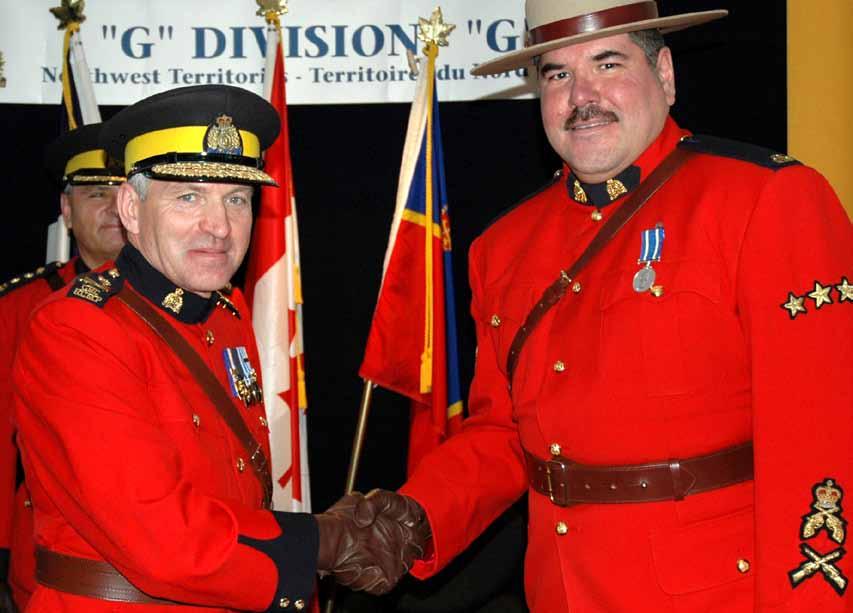
with in Inuvik. He was involved with the Not-US program. “I think that’s the right message. There are other things we can do to enjoy life than to go into drugs and alcohol.”
He is also involved in the launch of the Aboriginal Shield program in the near future. The purpose of the Aboriginal Shield program is to select leaders among youth and empowering them to be better. “Education is key in any prevention,” said Norris. “Everybody makes the decision whether they’re right or wrong. But it’s whether you have the information to making an informed one.”
In 25 years, Norris has seen a lot. He has raised a family, had a successful career and always did it with a smile. If he could pass one message on to young people in Inuvik it would be to “Always believe in yourself.”∞
SPRING 2011 Tusaaya∂sat 19
After 25 years of service
S/Sgt. Wayne norris receives his long service medal from Senior Deputy Commissioner William Sweeney.
Profile
Barbara Memogana
FULL OF PASSION
Barbara Memogana is an instructor in the Aboriginal Language Certificate Instructor Program at Aurora College. She is modest but irresistibly sweet and passionate about learning languages. Growing up on in outpost camp in Ulukhaktok, Memogana was fluent in Inuvialuktun. Later in life she travelled to attend teacher-training programs at University of Alberta, University of Calgary, and McGill. But the learning hasn’t stopped there. Currently, Memogana is now learning, with the help of elders, other aboriginal languages such as Gwich’in, Uummarmiut, and Siglit. Memogana is committed to the revival of Aboriginal languages in the North.
 PHOTO: S H afia uS man
PHOTO: S H afia uS man
Charles “Chucky” Gruben
A MAN OF ACTION
Chucky Gruben has represented the interests of Inuvialuit hunters and trappers locally and globally. Gruben uses the advice and wisdom of his mother and father as a source of inspiration and negotiating tool at wildlife management meetings here and abroad. Gruben is hardworking and always looking for a challenge. A hunter trapper himself, Gruben is now phasing into ecotourism. His new business venture is called Chuck Gruben Outfitting and Guiding. His advice to youth is to work hard in school and use their high school diploma as a stepping-stone to further education.
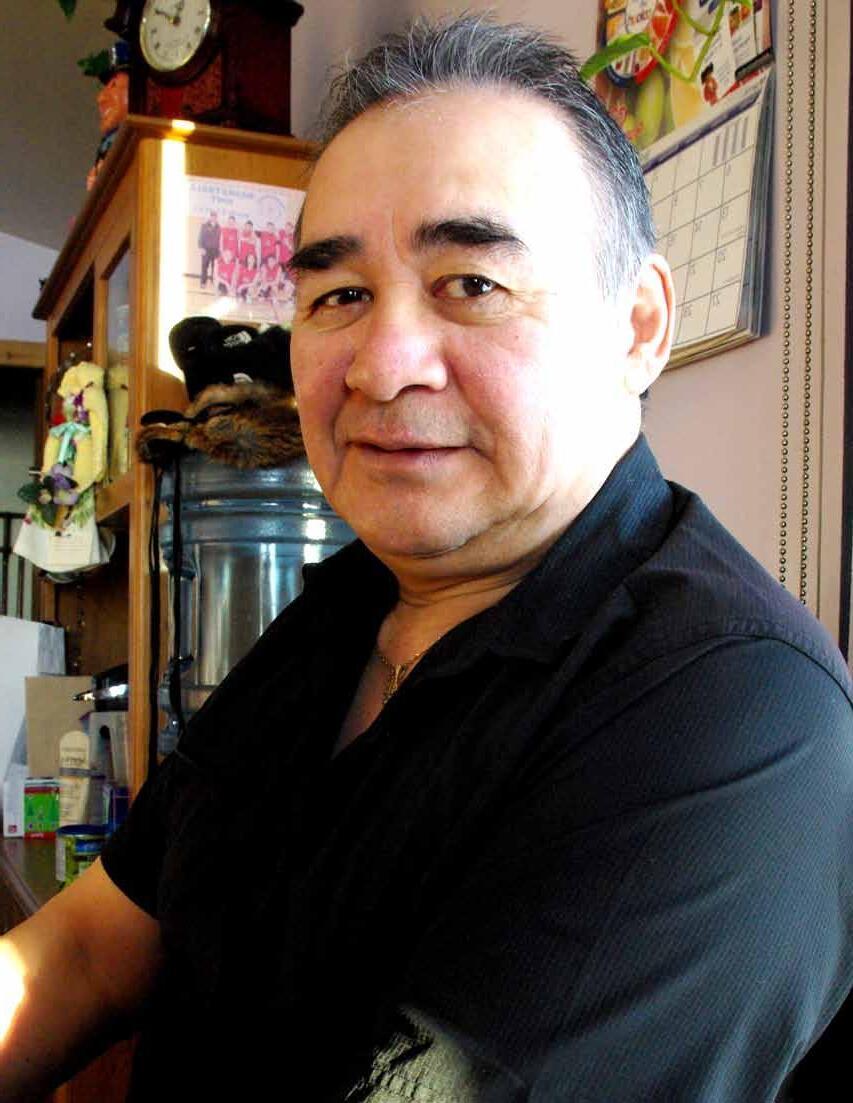
Profile
PHOTO: m aung Tin
greenland
Muskrat Jamboree
 By Shafia u sman
By Shafia u sman

none of the contestants in the race for King and Queen could remember the last time 6 couples ran for the crown. But that is exactly what happened at this years’ 54th annual muskrat Jamboree — six couples raised a remarkable $79,000 from a small community of 3,500 people. in the words of gerry Kisoun, a long time Jamboree volunteer himself: “it just goes to show what a number of committed volunteers can get done in this community.”
fundraising requires a lot of hard work and is instrumental to the success of the Jamboree. this year we asked 5 couples, who ran for King and Queen, why they took on the challenge and what were some of their strategies.

22 Tusaaya∂sat SPRING 2011
Jolene
Braeden Picek
t he 54th Annu AL
Erin Simon & Riley Maring-Blake
Dance instructors raising money for a good cause
Erin Simon was fussing over last minute details right before her Merchandise Bingo fundraiser when I arrived at Ingamo Hall for our meeting. The immediate impression that Erin made was that she’s serious, diligent and the one to look out for in the race for King and Queen. I felt like I had dragged her away from her tasks so that we could talk – but only briefly, of course, because she was anxious to get back to work.
Erin’s companion in the race was Riley MaringBlake, a shy but active high school student and soccer player. Both Erin and Riley are dance instructors with the Inuvik Friendship Dancers. They partnered together to raise money for the Muskrat Jamboree simply because they wanted to help out. When asked if competition was fierce Erin replied, “We’re just focusing on what we’re doing. We see it as a good fundraiser.”
But fundraising takes more than just the will to help a good cause. Erin and Riley are steadfast and enterprising. They organized a flea market, jail-and-bail, luncheon and auction to raise money. Together they raised over $23,000 which earned them 2nd place in the King and Queen race. Erin also advised, “you have to be gung-ho to do this, very motivated, energetic, friendly.” Erin had brought that friendly energy to their bingo event that night.
Maureen Keevik & Roger Anderson

A flourishing friendship
Every couple running for King and Queen were so different. Maureen Keevik and Roger Anderson were a riot. As we sat down at the department of public works conference room, straightaway Maureen started to make fun of Rogers’ hair while Roger pretended to be insulted and defended his hairstyle.
Maureen is a veteran fundraiser for the Muskrat jamboree. She was a contestant four times before and won the crown twice. This year she asked her friend Roger, who moved here from Toronto a year ago, to join her.
“This time we’re going to lose pretty bad,” Anderson made a self-deprecating prediction. Apparently, both Maureen and Roger were pressed for time and unable to organize big fundraisers. Roger is a project manager at the Department of Public works who travels a lot and Maureen is conducting field research for the ICC. But still, they sold tickets, held a 50-50 at the dome, and had a chili and doughnut sale.
Roger initially agreed to join Maureen in this endeavor because they were friends. Usually they have a great time playing darts and hanging out. “I said ‘why not?’ Maureen has always been good to me.” Plus, Roger likes to take any opportunity to strengthen his northern experience.

Maureen pointed out that Roger was the first black man to run for King in 54 years. “He made history,” she boasted. Roger is already planning to run again next year and the second time round he is going to be competitive. “I’m going to work really hard,” he pledged. “I have to make history by becoming king next year”
But all was not lost this year. These two friends still hung out and shared some laughs while making some extra cash for the Jamboree.
SPRING 2011 Tusaaya∂sat 23 PHOTOS: m aung Tin, S H afia uS man & E ric ZH ang
Chelsy Arey & Edward Cardinal High school Sweethearts looking for a Challenge
Chelsy Arey and Edward Cardinal were probably the shyest contestants in the race this year. But they raised $15,000 for the Jamboree. “We don’t care if we place or not,” said Chelsea. “Its just for fun. Something to keep us busy and out of trouble.” Yet they still managed to raise bucket loads of money and placed third in the competition.
Chelsy and Edward secured sponsorships from places like Bob’s Welding, IRC, Home Hardware, and Delta Cabs. They held 50-50 draws, merchandise bingos, and bake sales. But they confessed that Edward’s mother, Loretta, worked really hard to help them out.


Fundraising was a welcomed challenge and Chelsy found that this experience has helped her come out of her shell a bit. “At first I was really shy,” explained Chelsy, “Now I’m just out there [saying] ‘Buy tickets! Help support Muskrat Jamboree!’”
Chelsy and Edward said they appreciate the Jamboree because its’ “good for the community to come together, spend time with each other.” It is reassuring and refreshing to see such young people making a commitment to the idea of community.
Clara Elias & Pete Smith Beginning Anew
It has been two years since Clara Elias and Pete Smith triumphed over some very serious health issues. They also recently got engaged. Now that Clara and Pete have another shot at a healthy life, they don’t want to waste any precious moments. Clara explained that joining the King and Queen race was their chance to step out in the community and “show the people and the region these two people are healthy again…body, mind, and spirit.”
They started out very motivated to raise money by selling traditional crafts from Ulukhaktok, tickets and doing some 50-50 draws. Pete believed that Clara’s smile and personality was vital to fundraising, “She’s just got that personality that brings people towards her.” A few weeks into their fundraising endeavors Pete took a job that he loves at Northwind Industries. But working 12-hour shifts put a halt to their fundraising efforts.
Pete and Clara were content with the money they did raise for the Jamboree. However, true to their sweet and friendly nature, they also continued to support the Jamboree by attending fundraising events hosted by the other contestants. “I’m not out to be king and queen,” Pete explains, “We’re already king and queen here.” After all, the chance at a new beginning is a great privilege in and of itself.
24 Tusaaya∂sat SPRING 2011
Sallie & Richard Ross
Dedicated Soccer Parents Give Back
“We are definitely fundraising people,” said Sallie Ross as we talked in her living room on a Sunday afternoon. She looked pretty relaxed considering the fundraising events she and her husband had lined up for the week ahead of them.
Sallie is energetic, a nurse, and is a coach for the Delta Heat girls soccer team in Inuvik. Richard Ross has a mellow personality compared to his wife but is just as personable. He works for the GNWT public works and is also a skilled carpenter who built the house that they live in. Together they make a resourceful fundraising tag team.
Sallie talked eagerly about their fundraising strategies for the Muskrat Jamboree. Among them was an audacious fundraiser called “Jail-and-Bail.” People paid Richard and Sallie to have their unsuspecting friends, co-workers, or spouses “arrested” by an offduty RCMP officer. Among the jail-birds was Gerry Kisoun, a retired RCMP constable. After Kisoun was arrested, he had his mugshot taken and coughed up the $20 “bail” fine before he was let free.
“Being aggressive works well when it comes to ticket sales. But being innovative brings people in,” said an enthused Sallie. “By having different events, and trying to put a different spin on them. That’s what draws people in.” Another one of Sallie and Richard’s innovative events was a Chinese Luncheon at Ingamo Hall. It drew a huge crowd of people on a Saturday afternoon. While waiting in line the crowd made jokes and cheerful exchanges despite a 30-minute delay.
The night before the luncheon the Ross’ had two medical emergencies in their family that kept them awake until the morning. But Sallie and Richard are
not the type to be held back. They fried up a storm on the morning of the luncheon and filled Ingamo hall with the smell of ginger beef and served a colorful lunch of coconut shrimp, chop suey, and spring rolls.
While Richard and Sallie are tenacious fundraisers they acknowledge that they could not have done it without the help of their sisters, cousins, and mothers. Their key advantage was their supportive family network.
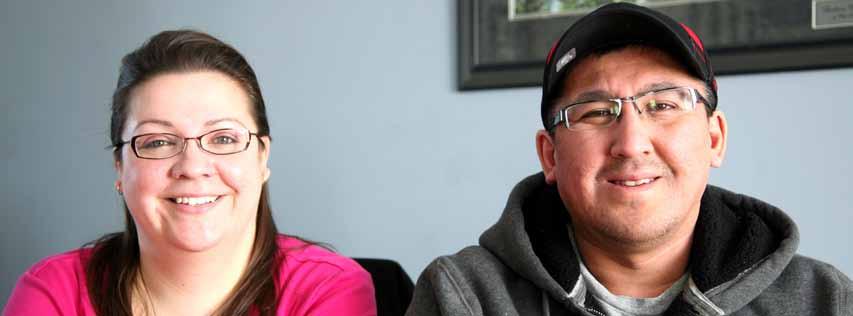
Sallie and Richard have a lot of fundraising experience behind them. They founded and coach the Delta Heat Soccer team for girls in Inuvik for the last 5 years. Every year the team raises money to attend Ernie’s Rock-Around-the-Clock soccer tournament in Grand Prairie Alberta. Many of the girls have flourished in spirit and skill. In the past, the Muskrat Jamboree has contributed monies to their soccer team.
This year it was Sallie and Richards turn to give back to the Muskrat Jamboree and they raised over $26,000 and took the title of King and Queen. Also, they did it all while simultaneously fundraising for Delta Heat soccer – which just speaks to their tenacity.

SPRING 2011 Tusaaya∂sat 25
Profile
Nellie Arey
A TRADITIONAL WOMAN
Nellie Arey killed her first polar bear at the age of 13. Raised by her grandfather, Paul Kayotuk, on the coast at Herschel Island, Arey has a wealth of traditional knowledge and skill Arey grew up in a time where work was not divided by gender. She can make a tent out of caribou skin, skin a seal, and knows how to live off the land.
Today Arey passes some of her trapping skills to her grandchildren. At the same time she strongly encourages her grandchildren to pursue a college education.
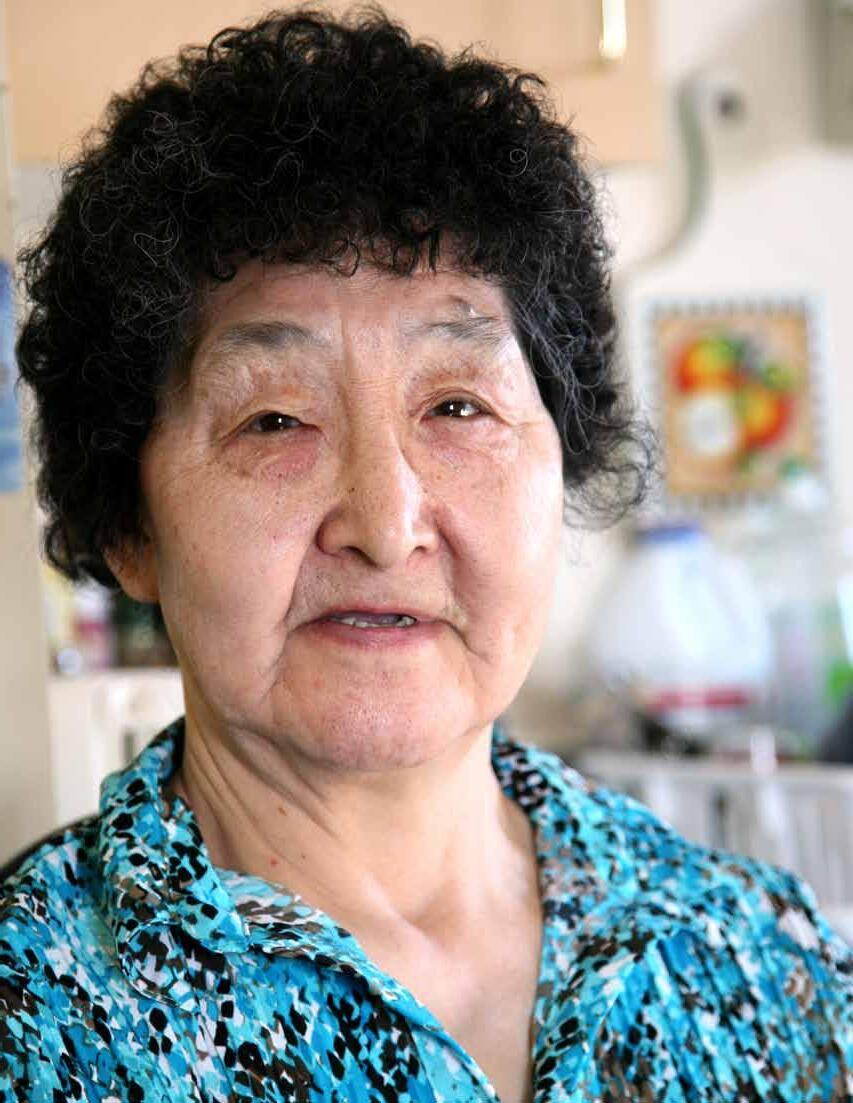 PHOTO: m aung Tin
PHOTO: m aung Tin
Joanne Ogina DETERMINED
Joanne Ogina is a Recreation Coordinator in Ulukhaktok. Ogina is always on the go. She runs the recreational programs efficiently and within budget, trains the people who work at recreational facilities, and runs between events committees and district education board meetings.
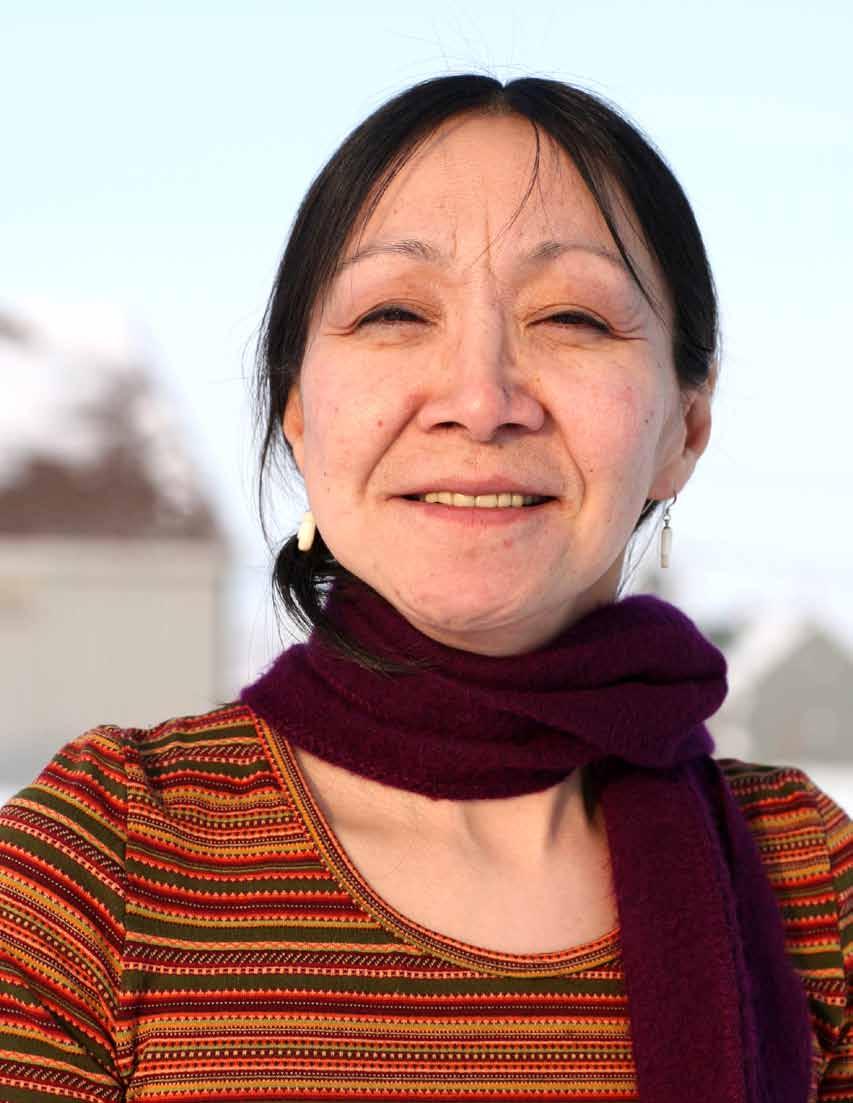
Ogina is determined and makes it her mission to take care of others. She works hard to get the best programs she can for her community so that the youth have a good foundation of programs to work with when they take over.
Her advice to the youth is to “respect yourself and each other.”
Profile
PHOTO: m aung Tin
EldEr Story:


A lesson on leadership
Translated by Albert Elias

William Mangilaluk is considered one of the first leaders of t uktoyuktak. Norman Felix is the grandson of William Mangilaluk and Norman inherited the gift of song and dance from his grandfather. In the following interview of Norman (conducted by Cathy Cockney and Florence Nasogaluak), he reflects on what qualities a person had to embody to become a leader in t uk almost a century ago.

In defining what makes a leader Norman finds it important to relate the story of how Uvayuak – who was the ataniq before William Mangilaluk -punished a man for sexually assaulting women -- revealing the importance that Inuvialuit leaders (and Norman) placed on the safety and honor of women.
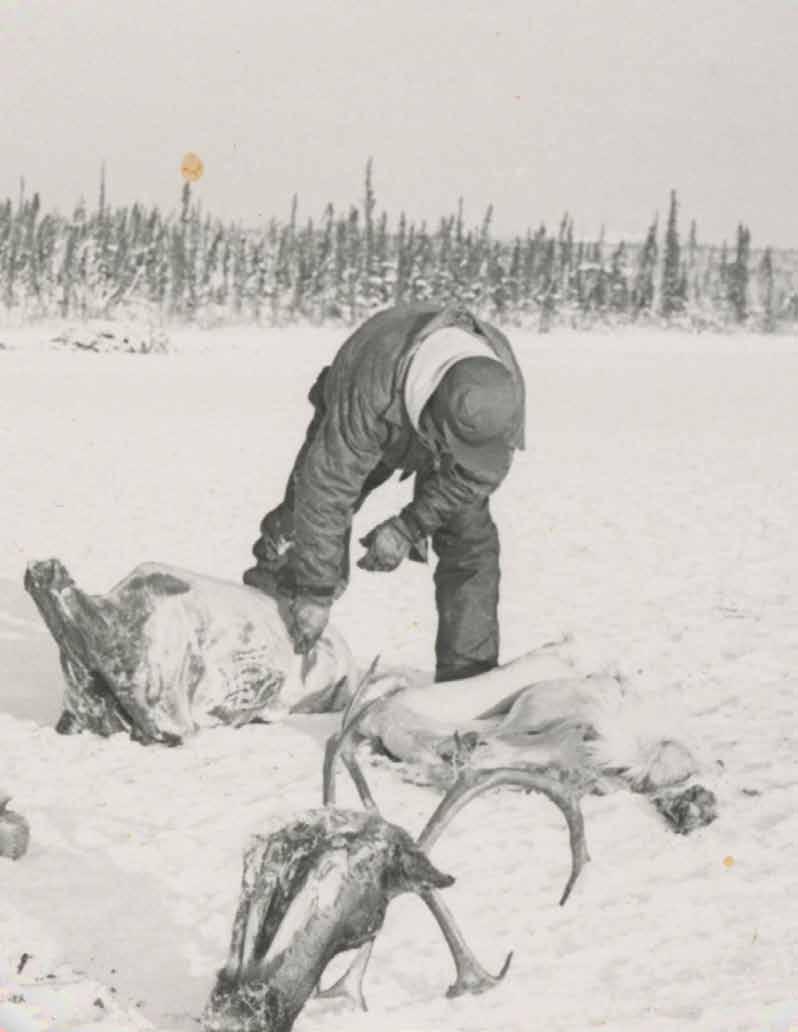
Norman Felix was born to Felix Nuyaviak and Annie Iqilana on November 24, 1929.
“A person who didn’t do too much wrong. The one who isn’t heading the wrong way, they always use for a leader. A person with a good mind. My grandfather too, my father’s adoptive father, Uvayuak was a chief before my grandfather, Mangilaluk. When Uvayuak died, Mangilaluk took over.
While Uvayuak, my adoptive grandfather, was chief there at Tuk, there was a single man who was giving the people problems. When the men went, this man would sexually bother their wives. He scared the women to do this. He was going too far so the elders, who were leaders, gathered together and decided he had to be killed for he had gone too far. Without telling him anything, they took him caribou hunting. They tricked him into going and they start playing a game with him to see who could jump the furthest. Every time he was going to jump, two men would go to the spot where he was to land. They tricked him so bad, he was really trying to win when,
finally, he fell on his back. Right away they grabbed him and poked him.
When they were going to stab him he said: “I’ll never do that again. Don’t poke me.” The knife never slowed, they poked him. After that, the people got good. When they returned, it was put that if anyone else make trouble, the same thing would happen to him. If a person was to cause trouble, he was to be killed. That man was the last man killed. By the time my grandfather, Mangilaluk, became chief, there was hardly no people in Tuk. All the elders were nearly gone.
…My grandfather and Nuligak [Bob Cockney] were leaders that time. Chief and assistant. When my grandfather died, Kaupqun [Emmanuel Felix Sr.] was chosen in his place. His assistant was Jonah [Carpenter]; he had no bad faults that time. “

Florence: Could they choose chiefs from other families? Or do they just pick them from one family?
“No. A person with a good mind with no serious faults was chosen.
Florence: Anyone?
“Anyone can be chosen. They just look up to him and Angagak put him first. So I think that’s how they choose him. I don’t’ know when Angagak; Kaupqun tell us this; Angagak said people can’t live right until they have a leader. They talked and choose Kaupgun as chief. Angagak was living in Tuk by then.”
SPRING 2011 Tusaaya∂sat 29
∞
EldEr Story:

Sivuliuqtuksat Ilitchuriyaksaat



Albert Elias Mumiktitanga
William Mangilaluk sivuliit atanrit ilagiyaat t uktuuyaqtuumi. Mangilaluum inru -
taalugiya taamna Norman Felix, atuutaillu mumrutaillu ilitait ataatangminin.
Uva uvani Cathy Cockney-mlu Florence Nasogaluamlu apiqsugaak Norman. t aima uqaqtuq inuguuq ataningurukkumi ingilraan qanuq ijusiruaqtuksauyuq.
Norman isumaliurami Uvayuam quliaqtuanga itqagimaya. Uvayuaq atanruyuaq William Mangilaaluum sivuani. Atausiaqluniguuq Uvayuam angun arnamik suuyaqliiyuaq akiragiya. Inuvialuit sivuliuqtit arnatik munaqirivialukpagait. Norman Felix irningak ukuak, Felix Nuyaviaq amalu Annie Iqilana. Novembert 24-mi 1929 annivia.
“Inuk kiglukuayuitkumi inuusirmini. Kiglukun qiviayuitkumi, taimani ataniuvaktuat. Isumatugumi. Ataatagalu, aapangma tiguuvia, Uvayuaq atanruyuaq Mangilaaluum ataatangma sivuani. Uvayuaq tuquman Mangilaluum ungavausiga.
Uvayuaq, ataataksara, ataniuman Tuktuuyaqtuumi, atautchim angutim inuuqatini nangitisimavagait. Angutit aularaangata taavyuma angutim nuliangit arniqutigivagait. Iqsitaaqlugit. Ingataumingasiman suqpangnaqiman tamatkuat innait katilutik tuqulugu isumaliqtuat. Quliutiyugarnagu isumamingnik tuktuliaqatigiyaat. Wiingayiblugu maliktitaat. Piuyaqatigiblugu aasiin qijgitaakiqtuat, kina taksiniarmangaan. Qijgiqsaraangan, malruk angutik tujviksanganun tutivaktuak.

Wiingayivailugu tajvani, uva akimasuktuq, niviqluni ulruhlaqtuq. Uvainatchiaq aasiin akuaqlugu kapitqaraat.
Kapiaqsigamijung uqalautigaluagait: “Taimaliutqilaittunga. Kapinanga” Savingmik kapitqaraat. Taima aasiin inuit quviatchaklutik. Inuit utiramik, tusarnaqiyuaq tajva kinaliqaa suuyaqliiniakiqpan, taimaliarmiyuaq. Tajva taamna angun kingulliq tuqutauyuaq. Ataataga Manglaluk ataningurman Tuktuuyaqtuuq inukittuq. Tamaitakapsak inirnirit suiqlutiklu.

Ataatagalu Nuligarlu (Bob Cockney) atanruvaktuak taimani. Iluratik ikayuqtigiiklutik. Ataataga tuquman Kaupqun (Emmanuel Felix Sr.) ataninguqtuaq.
Florence: Ataniksamingnik alanin pitaqsilavat? Uvaluuniin ilagiiktuat kisiita pivakpagit?
“Naagai. Inuk kinaliqaa isumatuyuaq nakuukpan atanrulayuq.
Florence: Kinaliqaa?
“Kinaliqaa ataningulayuq. Nakuuyiyuakpan inungnun taima Angakam ataninguqtita. Taimanakiaq ilipkagaat. Naluyunga qanga Angakam; Kaupqun quliutiyainni; Angagak tajva uqalaktuaq ataniruaqaaratik inuit ilurilaitugut. Uqaraluaramik taima Kaupqun ataninguqtitaat. Angagak Tuktuuyaqtuumuklunilu taimani”∞
SPRING 2011 Tusaaya∂sat 31
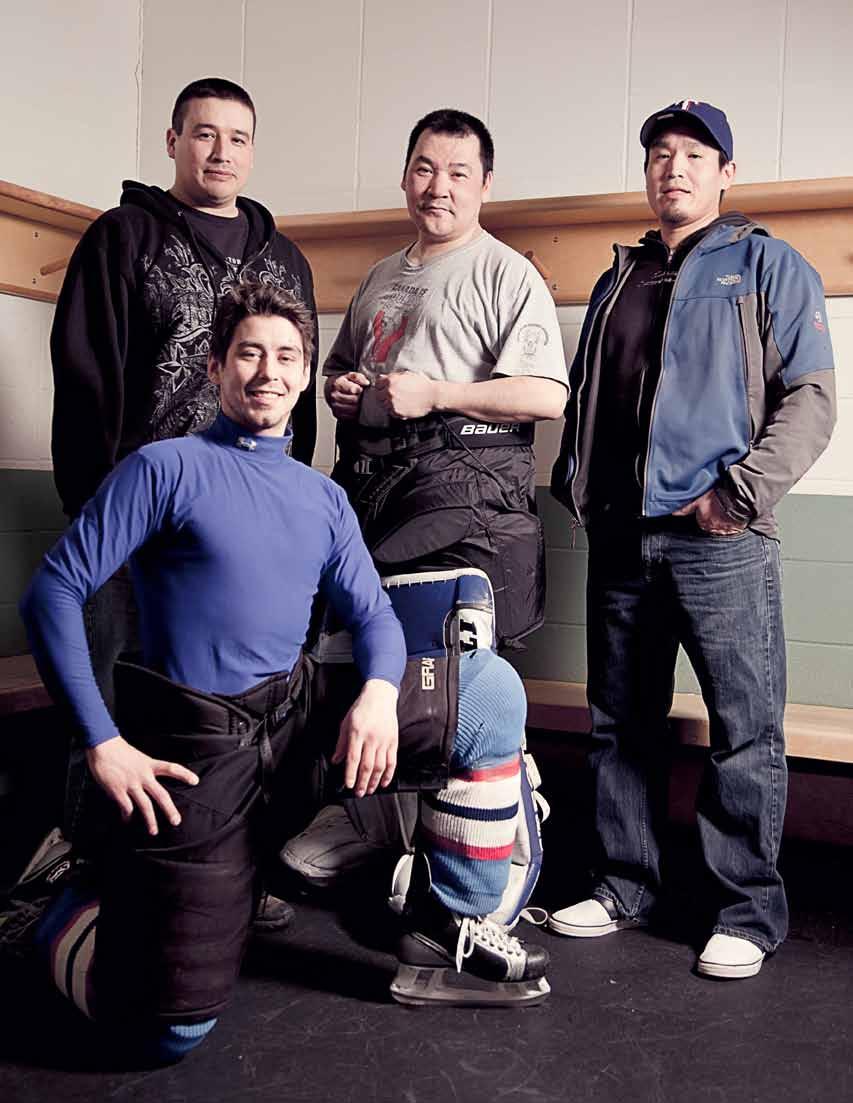
Hockey our Heroes
By Shafia U Sman
Jason Nasogaluak, Corey Wainman, Thomas Anthony and Mickey
Ipana will convince you that hockey boys grow up to be hardworking and courageous role models. All four of these men started to play hockey at a very young age. Today Jason Nasogaluak has 10 IRC cups under his belt. The other 3 played on Northwind this year and won the IRC tournament.
Hockey has taught them a lot – discipline, teamwork, and how to push oneself to the limit. But for this issue we talked about more than just hockey with our hockey heroes. We find out what inspires them off the ice, we ask them for relationship advice, and, of course, what makes them proud to be Inuvialuit.
PHOTO: Eric Z H ang SPRING 2011 Tusaaya∂sat 33
Jnasogaluak ason
nortHern Hockey's darkHorse
When I first meet Jason Nasogaluak I could not have guessed that behind his modest personality there was an extraordinary hockey story. Nasogaluak played street hockey all his life. In 1986 at the age of 15 he entered ice hockey. Nasogaluak is a pioneer of sorts because he was one of the first aboriginal goalies up here in the north. But what makes his story extraordinary is that Nasogaluak is a self-taught goalie.
Being the son of hardworking hunter-trapper, hockey wasn’t a priority growing up -- doing his chores was. In fact, Nasogaluak’s parents did not want him to play ice hockey because they were worried for their sons’ safety.
Nasogaluak recalled the night of his first game. While he was packing his gym bag, Nasogaluak’s dad came up to him and said, “Jay you shouldn’t play tonight. There’s a guy named Roy Ipana. He can break your ribs. He shoots hard, he’s going to break your ribs if he shoots you in the chest.” At the age of 15 and at 160lbs Jason was nervous. When someone pointed Roy Ipana out to him on the ice Jason recalled, “my legs started trembling, I started sweating in the net.” But that night he learnt to always know who was dangerous on the ice.
What’s more is that Nasogaluak could not afford the best goalie gear. But these things we might consider set backs, Nasogaluak turned to his advantage. Not having good gear meant that he played harder. Put
simply, he had to play hard because if he didn’t he would get badly injured. “I had to teach myself there was no other way,” said Jason. “To be successful you can’t be afraid. You can’t be afraid to play. You gotta be able to stand there and stop pucks. That was selftaught I guess”
I was so impressed that behind this humble and gentle personality was a determined and courageous man, and I asked him if he was aware that he is a role model? He modestly avoided my question and instead listed his own role models.
He told me that he learnt a lot from the goalies he’s faced but his parents equally shaped him. When I asked him what is the best advice his mother gave him he immediately responded: “Work hard.” As a wife of a hunter trapper Florence Nasogaluak worked very hard herself. Nasogaluak admired his hardworking parents and he tried to follow in their footsteps. In fact, despite his humbleness he revealed he is proud of something: that he never hurt his parents.
Later I asked Nasogaluak why he is proud to be Inuvialuit. For Nasogaluak being Inuvialuit is not a matter of pride but a matter of heart. He said that he loves to hunt and travel in this land; it is where he feels most free. Nasogaluak did not learn the language of his grandparents and parents but he loves listening to the elders speak Inuvialuktun. Even though he can’t speak it himself, his heart still understands.
Z H ang 34 Tusaaya∂sat SPRING 2011
PHOTO: Eric
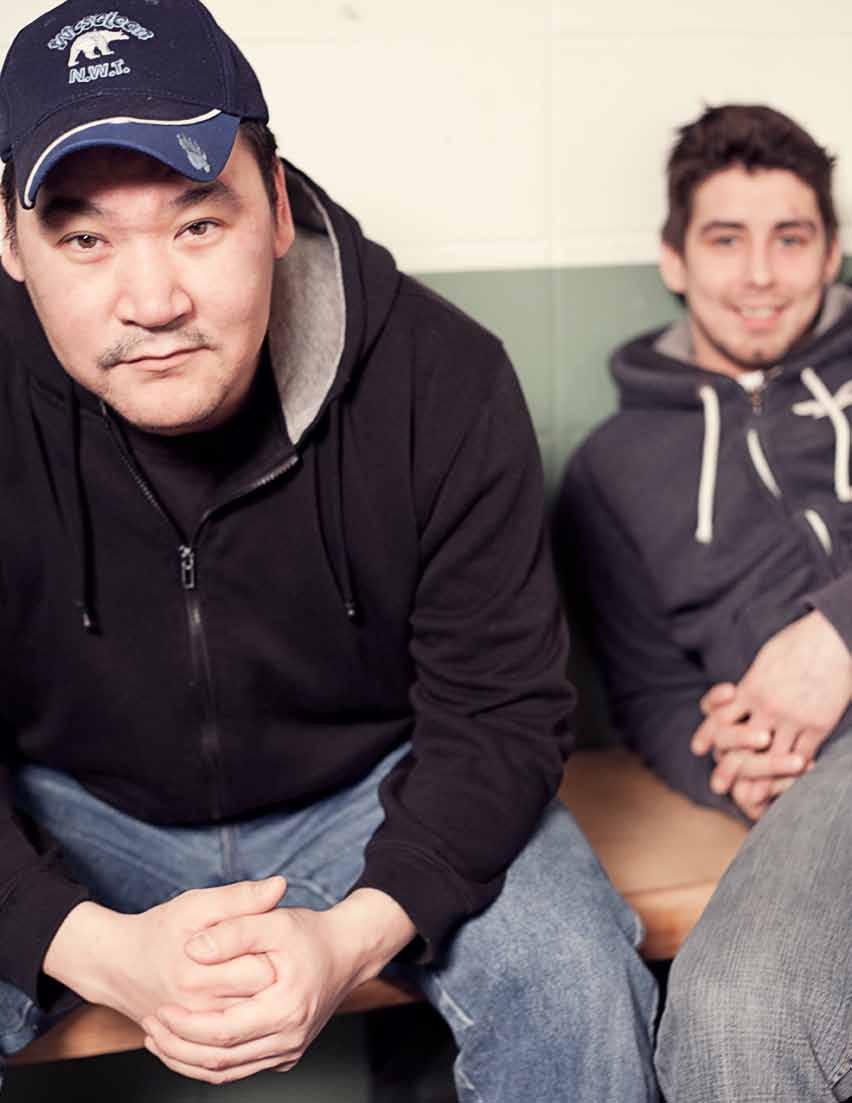
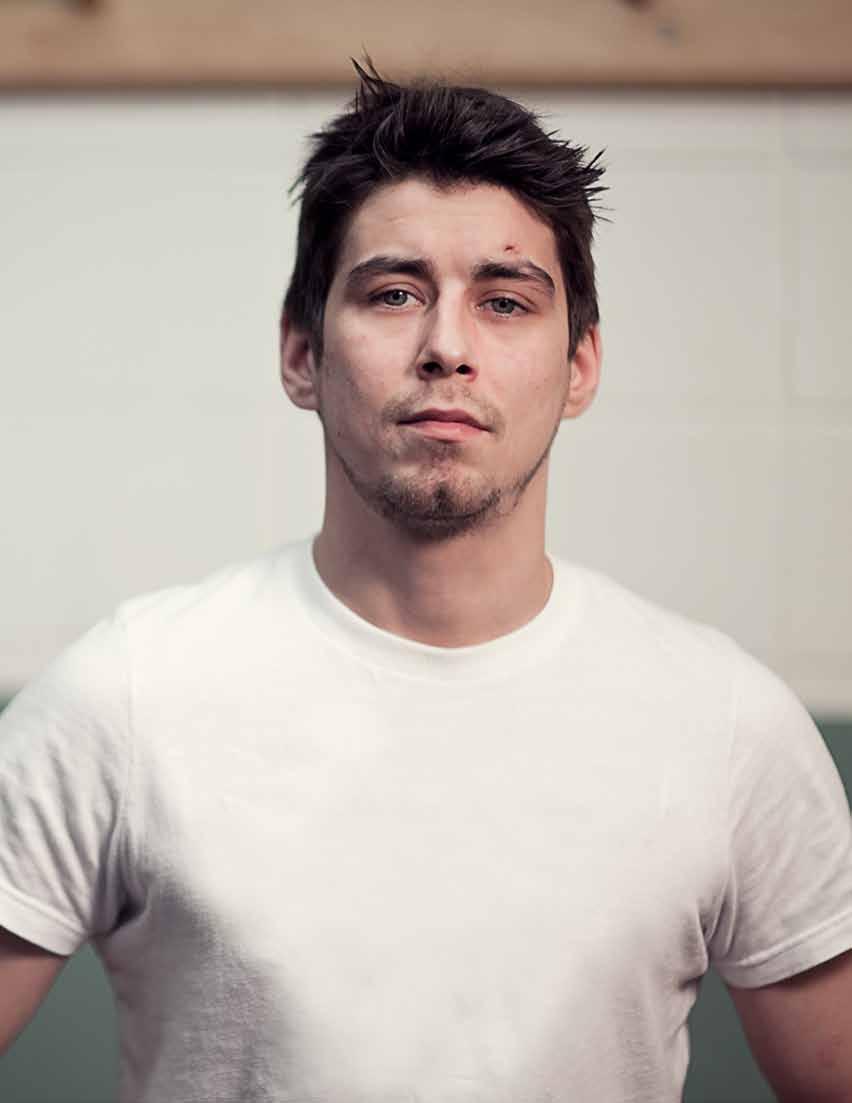
anthony thomas
winninG cHarM
Thomas Anthony is not one to shy away from attention. When I asked Anthony what drives him on the ice he replied with youthful confidence: “You know, why come and play soft when you can go all out,” said Anthony. “I like to put on a good show for the fans too. I want them to know that there’s a lot of good talent here. You want everybody to see it so you might as well show it while you can.”
Anthony started to play hockey at the age of 10 and his hockey idol was Tim Gordon. Since then he has turned into a skilled player and mentors young hockey players with their game. I ask him if it’s flattering or an overwhelming sense of responsibility that kids look up to him. “Actually I enjoy being a role model,” Anthony replied. “I like kids. I love kids. I’ll do anything to help them out. Keep them out of trouble. People did that for me so why not turn around and give it back.”
Anthony has a boyish charm and easy energy and I could not help but wonder what makes this guy so happy. After we talk about hockey I asked him what he is thankful for everyday. Without hesitating he replied, “Gotta a good woman, my family’s still healthy, strong, I’m working.”
Since it was apparent he was happy with his life and his relationship I asked him to offer some relationship advice and he calmly answered that he’s still “kind of young...still learning.” While he did not have much to say in way of relationship advice, he did reveal that his motto in life was to “Just be happy, keep going forward and never look back.”
What does Thomas Anthony like most about being Inuvialuit? “Traditional foods!”
Eric Z H ang SPRING 2011 Tusaaya∂sat 37
PHOTO:
wainman
younG fatHer & BusinessM an
Corey Wainman is a 36-year-old father of two and owns his own business. After a long day at work Wainman explained that hitting the ice is a chance to clear his head and feel rejuvenated. “I forget about everything for that one hour that I play,” said Wainman. “I don't live a stressful life, but I run my own business and it takes a lot of your time and a lot of your thought.”
But Wainman was MVP in 2010, which meant that not only was hockey an escape he was also very good at it. So I ask him to tell me what drives him to be a physically competitive athlete: “This tournament has been going on for years. You want to show everybody what you got. In order to be a winner you got to give it your all and if you don't give it your all you're not going to get anywhere in life. Whether its hockey or whatever.”
It is this same winning attitude that Wainman brings to the rest of his life. Wainman is a Civil Engineering Technologist and owns Coreman Technical Services, providing civil surveying and engineering services within the Mackenzie Delta Beaufort region since 2004.
But to get to where Wainman is today took hard work and persistence. When Wainman was in grade 10 and 11 many of his friends were dropping out of high school and he too was ready to drop out of school and get a job. He was lucky to have people in his life
that pushed him to not give up so easily. Some of the most important advice he’s received in his life was to be persistent and do not to give up easily. “Cuz nothing comes easy to you,” said Wainman. “If you’re looking for handouts, you’re going to be looking a long time. If you want something you gotta go get it.”
Not only did Wainman finish high school but he also pursued post secondary education and graduated with a diploma from Northern Alberta Institute of Technology in Edmonton in 1999.
Wainman has been married for 5 years to his longtime sweetheart. I took the opportunity to ask this young father and businessman for some good relationship advice. With his nice natured laugh he said “You gonna win some and you gonna lose some. It’s honestly a give and take. Its like anything else, you’ll only get out of it what you put into it. And communication is a big thing. You have to have open lines of communication.”
When I asked him why he’s proud to be Inuvialuit he replied, “Even though we live in a small town and there’s not many of us and we all know who each other are. Sometimes we don’t get along with each other but when we need to we can look beyond our personal differences and help each other out. I think that’s one of the reasons why I love living here so much.”
Eric Z H ang 38 Tusaaya∂sat SPRING 2011
PHOTO:
corey
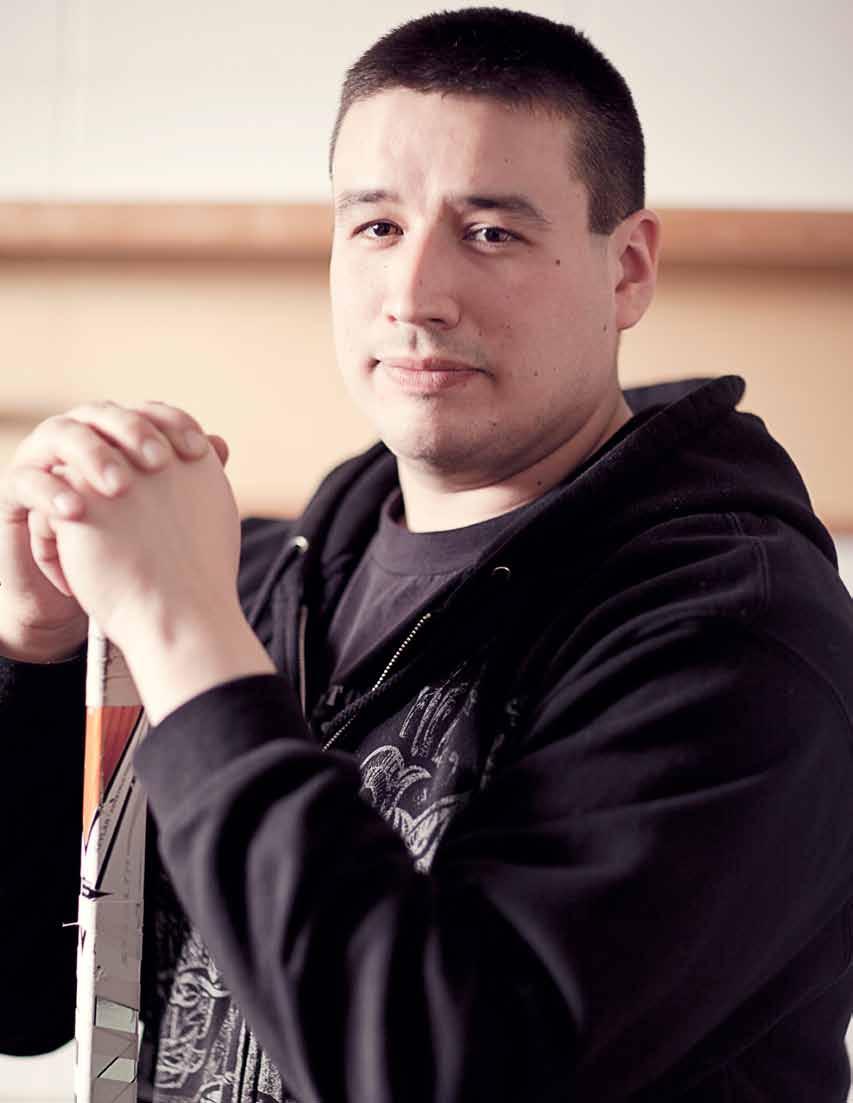
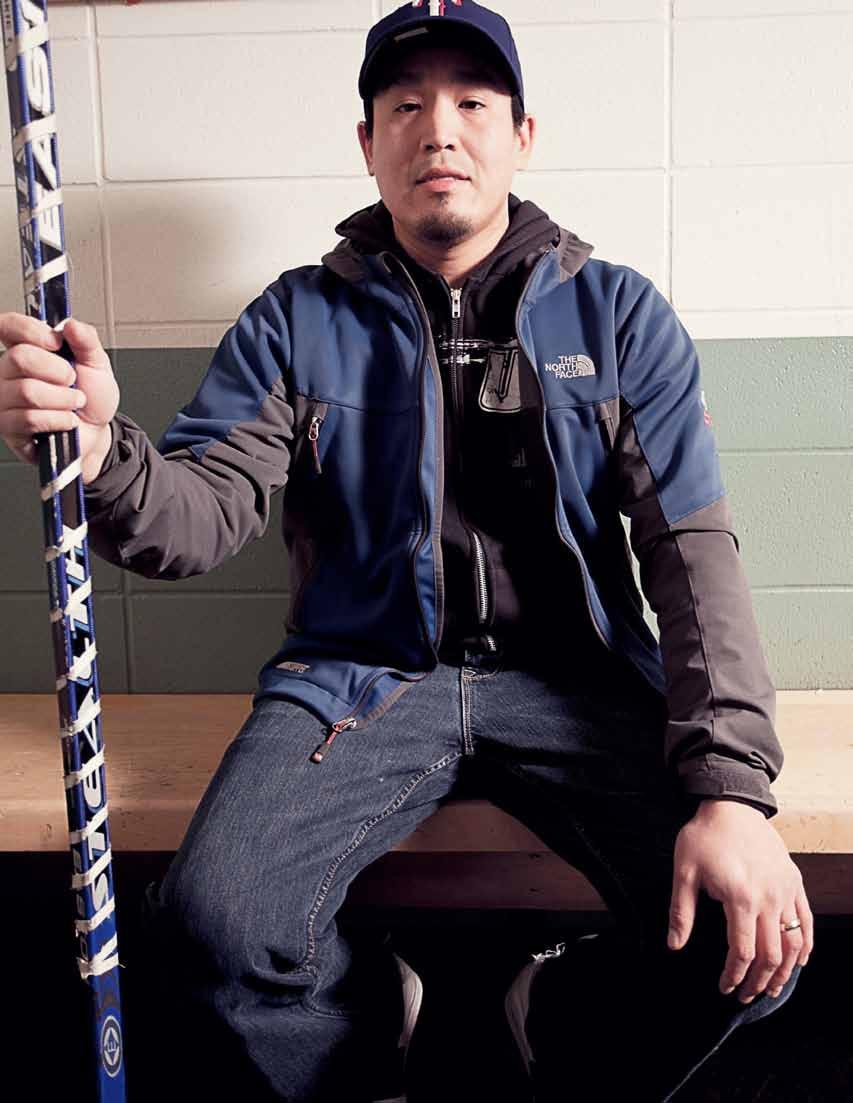
ipana Mickey quiet strenGtH
Mickey Ipana was awarded MVP at this years IRC tournament. So I asked how and why does Mickey Ipana bring his best to the ice? “Competition. It’s fun. I just love playing,” answered Ipana. “We have a big tournament here once a year. Everyone focuses on that tournament. There’s always talking about who’s playing for who and excited about the tournament. I just like to be focused and play for my teammates.”
Ipana has also given back to the hockey community and culture by organizing the rec league in Inuvik. The rec league currently has 4 teams and 52 players. Ipana and I sat and talked at the arena named after his father. I learnt a lot from what Ipana said but also from what he did not say. Ipana is blessed with beautiful manners and a quiet strength (that is hard to capture on paper). I asked him who his role model is and he replied, “Oh, my dad for sure. He’d seen something special in everybody. Didn’t matter what your race or how big you are, he knew inside everyone had something special. He just tried to help people to see it.”
Ipana’s is equally thankful for the role his mother has played in his life. Over the years Ipana’s mom has advised him to watch over his brothers, stay in school, get a good job, and raise a family. “Knowing she’s there to support me. I’ve been lucky enough to have her around for as long as I have.”
Sandra Ipana has done well. At 28, Ipana is a sensible family man, excellent athlete and full of young wisdom. On marriage Ipana shares that “you got to know that you’re going to run into problems. It’s about working things out. It’s about staying by each other and staying strong for each other. Just follow your heart basically.”
As for his motto in life he said “Whatever you do just try your hardest. Whether it be work, sports or education. Whatever you do just put everything you have into it. Everybody has something special in them.” Ipana continued “It takes a while to find it for some people. So whatever I do I just try my hardest, If I can’t find the answer I find a way to find the answer. If I know the answer then I try to spread the answer.”
When I asked Ipana what he loves about being Inuvialuit he struggled because there are so many things he loves about being Inuvialuit – the elders, the children, the northern games. But ultimately Ipana loves “the community”. Regardless of the differences there are between people the community will come together in hard times. Ipana said, “knowing that everybody has such a great heart, it warms my heart telling you that you know there’s love out there no matter who you are.”
PHOTO: Eric Z H ang SPRING 2011 Tusaaya∂sat 41
The FuTure Faces OF NOrTherN hOckey
Inuvik Minor Hockey Association hosts its 10th Gwich’in Cup Tournament.


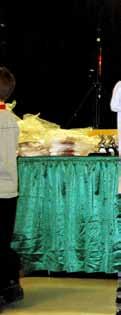


In the last 10 years the Gwich’in Cup Tournament has welcomed all children in the Delta to the tournament. When a small community does not have enough young players to make a team the tournament will take individual children and put them on a team. The Tournament also optimizes the time that young players get on the ice. The tournament has no Mercy Rule. Even if there is more than a 10-point advantage, the game does not end early. At the end of the day the Tournament just wants the children to play. Its minor hockey, “Delta style”!∞
Opening ceremony puck drop with Chief herbert Blake and William koe
Midget Division Champions. Lennie gruben, Samuel gruben, Mathew Jacobson, Michael krengnektak, Davis Luas, Sasha nogasak, Charlton Panaktalok, chad Pnaktalok, Carson Pokiak, James Pokiak-thrasher, Mathew Steen, richard teddy, Brennan Wolki, kevin krengnektak with coach Pat kuptana
Davina McLeod being awarded MvP 2011 for the PeeWee division. With her is Conrad Baetz, President of Inuvik Minor hockey Association.
PHOTO S : S H afia uS man






 novice division players at the opening ceremony
novice division champions. Dylan Doornbos, kyra McDonald, Leesha Setzer, kierra McDonald, Steven Pope, ty norris, kieron Clement.
PeeWee Division Champions. Corey Cockney, Jesse elias, Cole Felix, Donald kuptana, Larson nasogaluak, Jaimison Wright, Jimmy Stewart Jr., Davina McLeod with coach Pat kuptana
gwich'in Cup tournament 2011
novice division players at the opening ceremony
novice division champions. Dylan Doornbos, kyra McDonald, Leesha Setzer, kierra McDonald, Steven Pope, ty norris, kieron Clement.
PeeWee Division Champions. Corey Cockney, Jesse elias, Cole Felix, Donald kuptana, Larson nasogaluak, Jaimison Wright, Jimmy Stewart Jr., Davina McLeod with coach Pat kuptana
gwich'in Cup tournament 2011
be Let there
Art
There is a story dating from the 1950s, which recounts how printmaking started in the Inuit communities of the north. It is said that Oshoweetuk, an Inuit sculptor pointed to a duplicate image on several packages of cigarettes and asked how it was reproduced. James Huston, who was working with the Hudson Bay company at the time, illustrated the technique of printing by rubbing ink onto a piece of incise bone and then laying it on a piece of toilet paper; when he pulled it up the relief image carved into the bone transferred to the paper. Oshoweetuk looked at the printed transfer and said, “We could do that.” Shortly after, the first printmaking studio opened its doors in Cape Dorset. Not too long after, Povungnituk, Ulukhaktok (previously known as Holman), Baker Lake and Pangnirtung followed Cape Dorset’s example and created economic opportunities for the local Inuit artists.
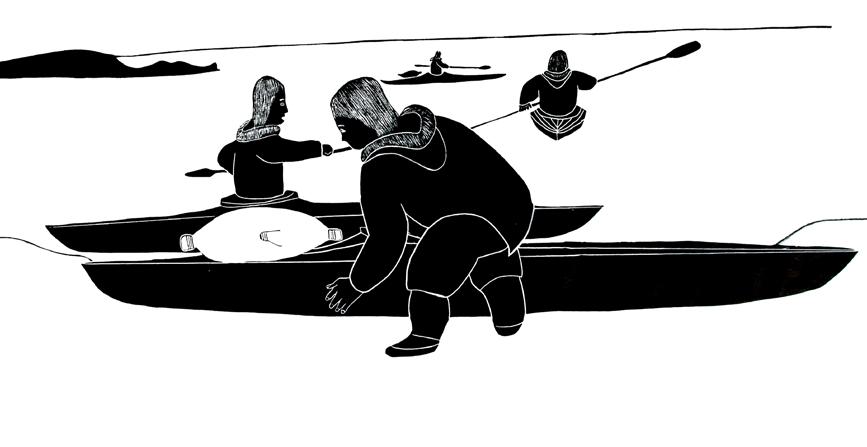
Today, Ulukhaktok prints contribute a significant
 By k aren Cornelius
By k aren Cornelius
component to the identity of this place, where the artists have been inspired by the areas traditional way of life, keeping the past alive, while creating an important historical record. The prints, which focus on traditional stories, cultural practices, legends and mythologies, have been important in affirming cultural pride. Printmaker Mable Nigiyok is one such artist, and points to the stories that her father and his friends told and the songs they sang, and which now inspire her work. She says, “they thought I should put these stories and songs on paper so they can be shown around and others can know how we lived.” In addition, the prints coming out of the North have allowed outsiders to appreciate the richness and diversity of Inuit culture and have given the artists some income.
The first Holman prints were made by cutting a design into a piece of tanned sealskin, after a razor had shaved the skin’s hair. Colour was then transferred with a toothbrush soaked in ink. Alec Aliknak Banksland and Harry Egotak created the first sealskin
44 Tusaaya∂sat SPRING 2011
stencil prints in 1963. Later, Elsie Klengenberg, Mable Nigiyok and Mary Okheena began to create complex stencil prints, replacing sealskin stencils with Mylar overlays.

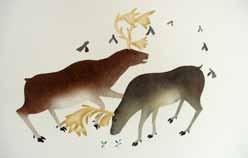
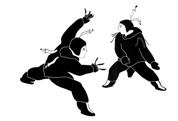
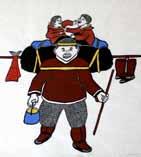
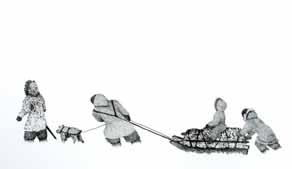
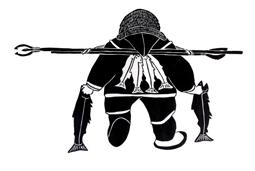
Unfortunately, the Holman Print Studio closed its doors in 2000 due to financial difficulties. The closing of the print studio was devastating for the printmakers. For 10 years they had no access to the printmaking equipment. Although a number of the printmakers continued to create small stencil prints in their homes, the quality of their work suffered and the subject matters that they printed remained static.
Through great efforts from various organizations, however, the Ulukhaktok Arts Centre was reopened in 2010. Artist Susie Malgokak coveys what this meant: “when the art shop closed for ten years it was very hard for us who depended on the art shop. We are happy that it is open again so we can start making prints again.” Lynn Feasey, an art consultant, proclaims that this is a great first step for Ulukhaktok print artists to produce creative works and help themselves economically.



Printmaking images made in the Canadian Arctic by Inuit artists offer a unique prospective by the Inuit people in Canada. Inuit prints have become a recognized Canadian art form and are respected and collected both nationally and internationally. Access to this printmaking facility is a significant step for the growth of the artists, and it allows for contemporary work to reflect the North and reintroduce an important aspect of the Inuit culture in a rapidly changing world.∞

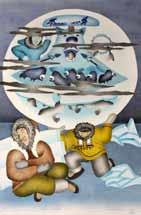 Mable nigiyok
Printmaker Louie nigiyok
Mable nigiyok
Printmaker Louie nigiyok
culture on camera

in late February, winter hangs onto its last icy breath with a vengeance, threatened by the return of the mighty sun. She reminds us that Spring has not yet arrived. Spirits tend to be low during this time, and motivation scarce. It’s a good time to celebrate! From February 25th to March 2nd, 2011, Ulukhaktok did just that. Culture Week was part of a community development project funded by the IRC, ITI and CanNor. The week long celebration of culture included two community feasts, drum dancing, filmmaking, printmaking and knitting workshops, film screenings, and a community igloo building project.
The idea behind Culture Week was to encourage further participation in the workshops, while providing unique opportunities for filming and learning. With the recent reopening of the arts centre, the opening of the new community centre, culture was happening everywhere in Ulukhaktok. Culture on Camera offered something unique and exciting for eight curious senior students from the Helen Kalvak School, who immersed themselves for six days into the world of filmmaking.
The workshop was designed to teach youth how to document stories and events in their community. It’s part of a larger project in the works, to involve youth and share stories with other communities around the north and around the world through the internet. But first, the skills need to be learned. When put into the hands of these enthusiastic youth, the cameras became
By Lynn Feasey
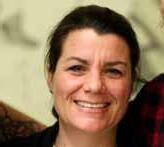
a tool for artistic expression, creative thinking, storytelling, cultural preservation and a new way of looking at the world and their very own community.
Students were encouraged to go outside with their cameras and their imagination and explore their community. Using their video cameras, some experienced many things for the first time, including a visit to the Ulukhaktok Arts and Crafts Centre where they filmed and interviewed artists and staff. One of the participants, Manuk Watson Kudlak, was particularly interested in making videos around town. “There are valuables in my community. I think its good to get our stories and events on film, because they may not be there one day.” He explained.
Storytelling was a way of life for centuries. It was how people learned. Today, stories are no less important, but the way we tell them has changed. As Inuvialuit filmmaker, Dennis Allen remarked, “Without story, you have nothing. We all have the capacity and intellect to construct a story, but it gets lost in our voice. Film allows us to access that capacity and intellect. It gives the youth a tool to apply to storytelling.” Allen learned how to tell stories from his father. “I just took it a step further to reach a bigger audience.”
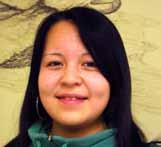
To Allen, an accomplished filmmaker, musician and storyteller, it is essential that youth know and learn their own stories. “This will benefit youth by giving them an opportunity to channel their voice other than through orating, which is traumatizing to many youth, for many reasons.” In these changing times, youth


46 Tusaaya∂sat SPRING 2011
remain respectful of their elders, but also need to find their own voice. “We don’t have the social barriers we once had, education is more accessible, social media and new media are modeling the method that youth can relate to”, says Allen.

Allen documented the traditional methods used by the elders in igloo construction, as well as the activities of the young filmmakers. The documentary will highlight the passing down of traditional knowledge, as well as the development of new skills by the youth. Allen was encouraged by the response to the project. “The community saw it’s youth documenting a way of life that is dying. The youth will be now expected to use those skills. At least one of them will take an interest in this medium of storytelling.” he said.
Elliot Malgokak, who nearly missed out on the opportunity, learned that filmmaking is more than just using a camera. “ I had little interest at first, because I’m a physical person, and I like to do physical stuff. But I would like to learn more about filmmaking now.” He also saw the value in telling stories. “ I didn’t know how to preserve our culture before”. Malgokak sees a glimpse of his future “ the workshop was very valuable to me, I can get a job with this. I learned how to make films and edit them.”
While traditional knowledge and storytelling were a central focus of the workshop, content was up to each individual. For students like Kudlak, an aspiring DJmusic became the subject of one of his projects. “What I liked best was the music video Jay and Loren helped

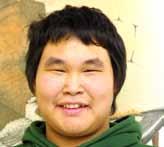

me make with the other young film makers of Ulukhaktok and the experience was awesome!”
While there is still a lot to learn, the students showed tremendous dedication and enthusiasm during the workshop. “It would be great if there was a follow up workshop just to brush up on their skills and to enhance them”, said Joanne Ogina, the Hamlet’s Recreation Coordinator.
The community plans to support the development of these skills. “I will be asking the students to record community events, Easter, 2011 High School Grad, Kingalik Jamboree, Canada Day, BJO golf tournament, Christmas events, etcetera.” said Ogina. “From a community perspective, we are proud of these students and the skills they’ve learned.”
The workshop ended with a very special night, celebrating the work of the students with a mini film festival held at the community centre. A screening of the student’s individual projects, along with a 12 minute documentary made by the group, was presented to the community. Mentors Jay Bulckaert and Loren McGinnis prepared special awards for each student, honouring their individual talents. The students were visibly thrilled with their honours, but the real surprise came when the cameras were given to each of the students. The catch? As the ‘keepers of the cameras’, the community can call on these young filmmakers, not only tell new stories, but keep old ones alive.∞
PHOTO S : Pa T rick k an E & m aung Tin SPRING 2011 Tusaaya∂sat 47
(Left to r ight) Jasmine k lengenberg, keith kataoyak, Film making mentors Jay Bulckaert, Lynn Feasey, and Loren Mc ginnis., gayle Ogina, Simon kudlak, troy kataoyak
Artful & Athletic
These figure skating starlets bring precious charm to the ice. Each year the figure skating season begins in October and ends with a figure skating carnival in March. This year’s theme was “The Golden Year. The best of Movie and T.V.”∞
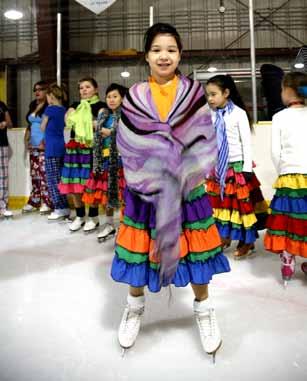

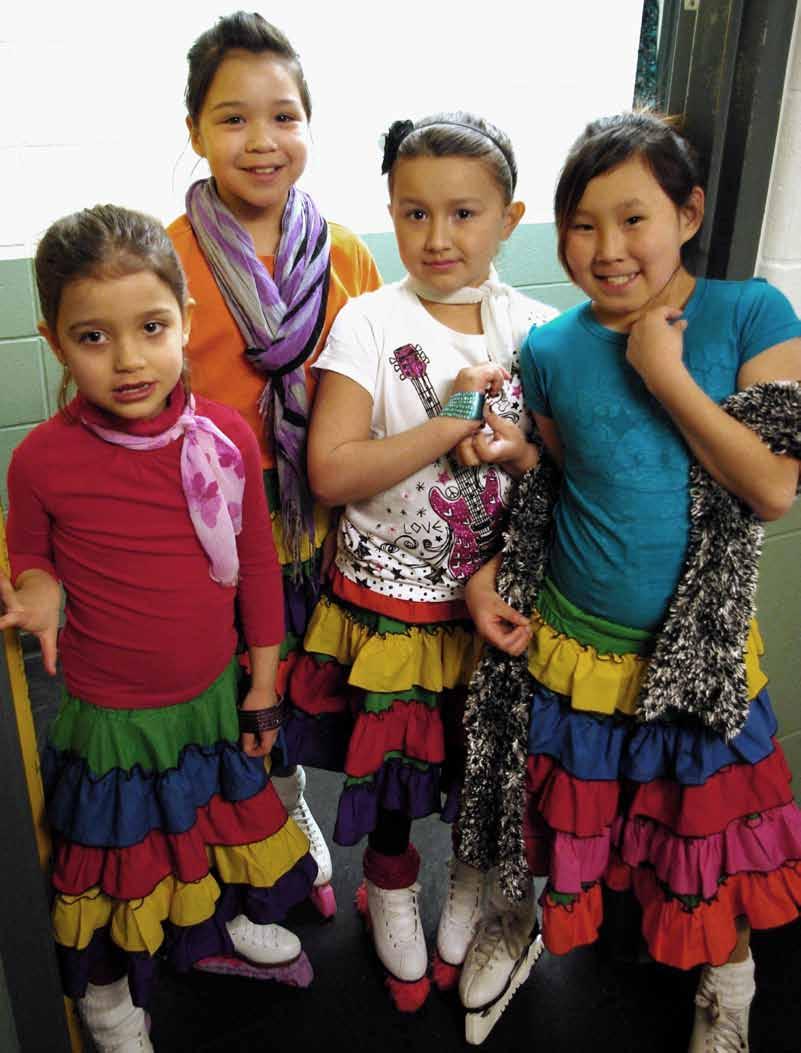 Makayla kikoak
Left to right: Shaquella kaglik, kiersten rogers, katelynn Crocker, Maya krizan, Ally engram
Left to r ight: Myja Semmler, Makayla k ikoak, Paris Wainman, Destiny Pokiak
Makayla kikoak
Left to right: Shaquella kaglik, kiersten rogers, katelynn Crocker, Maya krizan, Ally engram
Left to r ight: Myja Semmler, Makayla k ikoak, Paris Wainman, Destiny Pokiak
Fun & Fitness
Inuvik Ski Club wrapped up its season with the 43rd annual “Top of the World Ski Loppet” event.
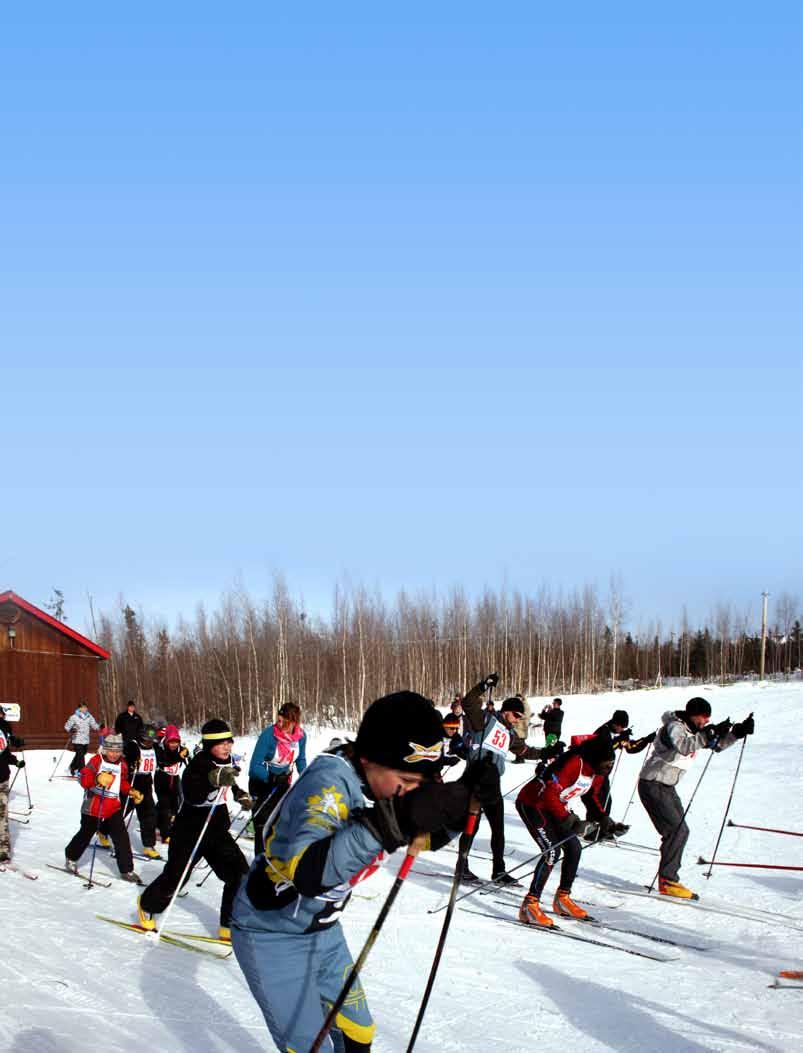
There were 37 participants in this years’ Loppet – 20 adults and 17 children. Some dominated the trails while others wiped out at every turn, but everyone had a great time and left with a smile. In the past Inuvik Ski Club produced competitive skiers in the Mackenzie Delta area. Among the most renown are twin sisters Sharon and Shirley Firth.
These two women competed in 4 winter Olympic Games!
Local support is fundamental to making Inuvik Ski Club competitive again. Melissa Lennie, Melinda Gillis, and Jeremy Hansen are among some of the Inuvik Ski Club volunteers working towards rejuvenating skiing in the Mackenzie Delta.∞
top of the World Ski Loppet taking off.
September 19, 2011 is the deadline for Common Experience Payment applications.

The Indian Residential Schools Settlement Agreement. The healing continues.
On September 19, 2007 the Indian Residential Schools Settlement became effective. At the time, it was estimated that 80,000 former students were alive in 2007. As of January 1, 2011, Common Experience Payments have been issued to 76,623 former students. An important deadline is now approaching.
Under the terms of the Settlement, September 19, 2011 is the Common Experience Payment (CEP) Application Deadline.
What is a Common Experience Payment? It is a payment made under the Indian Residential Schools Settlement Agreement to former students who lived at a recognized Indian Residential School under the Indian Residential Schools Settlement Agreement and who were alive on May 30, 2005. Payments are $10,000 for the first school year (or part of a school year) plus $3,000 for each additional school year (or part of a school year).
please complete and submit an application form by September 19, 2011. To get an application form, please call 1-866-879-4913, go to the website or visit a Service Canada Centre. Service Canada staff members are available to help applicants complete the CEP application form.
What if I have already applied for a Common Experience Payment? If you have already applied please do not submit a new application. If you have not received a decision or have questions about your CEP application, please contact the phone number below.
For more information call 1-866-879-4913 or visit: www.residentialschoolsettlement.ca
Which schools are included? The list of recognized Indian Residential Schools has been updated. Six Indian Residential Schools have been added; decisions regarding a number of other schools are in progress. A complete and updated list of recognized residential schools is available at the website listed above.
How do I apply for CEP? To apply for a Common Experience Payment,
What about the Independent Assessment Process? The Independent Assessment Process (IAP) is a separate out-of-court process for the resolution of claims of sexual abuse, serious physical abuse, and other wrongful acts suffered at residential schools. The IAP is a complex process and it is strongly recommended that you hire a lawyer if you wish to submit an IAP application. CEP and IAP are separate processes and former students may apply for the CEP, or for the IAP, or for both the CEP and IAP. The deadline to apply for an IAP payment is September 19, 2012.
More information on both processes is available at 1-866-879-4913 and at the website. The IRS Crisis Line (1-866-925-4419) provides immediate and culturally appropriate counselling support to former students who are experiencing distress.
Official Court Notice
September 19, 2011 qaangiutikpan taamna Akiliusiarun (Common Experience Payment) isuk-kaqtuksaq.
Itqilit Tuk-kuvigibluglu Ilisarvingat Angiqtaq Makpiraaq
Nakurumun Igliqtuq
Taamna Itqilit Tuk-kuvigibluglu Ilisarvingat Makpiraaq aulaqiyuaq September 19, 2007-mi. Inugiaktilaangit ilisariaqtuaq taimani kisinnamigit 80,000 qanimaksimayuq. January 1, 2011-mingaaniin 76,623 ilisaqtuat Tuk-kuvingni akiliusiaqtuat. Tajva taavyuma isukautiksaa qaglimaakiqtuaq.
Malirutaksani makpiraani tajva aglaksimayuq Akiliusiarukkuvit (CEP) makpiraat san-naiqtaksatin September-mi 19, 2011.
Suna uva Akiliusiarun?
Akiliusiarun ilisariaqsimayuan-nun ilatik qimaklugit, tuk-kuviit igluqpait nayuqlugit ungavani. Ilisaqtuan-nun suli inuuyuan-nun May-mi 30, 2005. Sivulirmik ukiumi $10,000-mik akiliusiaqtuat (ukium avaraluanganik). $3,000-mik aasiin ukiut al-lat (ukium avaraluanganik).
Akiliusiaruk-kuvit, makpiraat sanaiqtaksariyatin September 19, 2011. Makpiraat pisuk-kupkit una ququarnaqtuq, 1-866-879-4913, qaritauyakulu. Service Canada-mlu ikayuqtingit upangnaqtut. Service Canada-m savaktingita ikayulagaasi tamatkirlugu makpiraat.
Suvaptauq apiqsimanik-kuma taavyumunga Akiliusiarnikun (CEP)? Apiqsimanikuvit taavyumunga alamik piyaksaituq. Tusaapkangitpatin apiqsuutiruaruvit Akiliusiarutigun (CEP) uqaqatiginaqtut (1-866-879-4913).
Uvuuna apiqsurnaqtuq: 1-866-879-4913: Qaritauyak-kun: www.residentialschoolsettlement.ca

Naliit Uva Ilisarviit Ilauvat? Makpiraan-ni aglaksimayut tutqiqsaqsimayut nalun-naiqsimayut. 6 al-lat Ilisarviit ilaliutimiyuat; al-lalu Ilisarviit itqagimagait. San-naiqtaq makpiraaq Ilisarviit atingit aglaktat takunaqtuq.
Qanuq uva apiqsuqtuksami tajvunga Akiliusiak-kun?
Suvaptauq uva taamna Independent Assessment Process? Taamna IAP alauyuq makpiraaq sanaiqtaksaq suuyaqliiptauguvit. Nuyulilutin suuyaqliipkaqtauguvit nangititauguvit ilisarvingmi itil-lutin. Taamna IAP sapirnaqtuq sivituyurlu. Uqaqtiksarnik (lawer) ikayuqtiruaruvit iluatqiyaq. Taapkuak CEP-lu IAP-lu alagiiktuk. Iluratik taapkuak aturnaqtuk. September 19, 2012 qaangiqpaung IAP nunguniatuaq.
Kiilu ilitchurisuktuni uva: 1-866-879-4913 qaritauyakunlu. Taamna Itqilit Tuk-kuvigibluglu Makpiraaq (IRS Crisis Line) uqaqatiginaqtuq uvuuna: 1-866-925-4419. Ikayuqtit sanait-tut tajvani. Ikyuqtiruarukkuvit.
Uqaqtitaaqtit Tusaatquyut

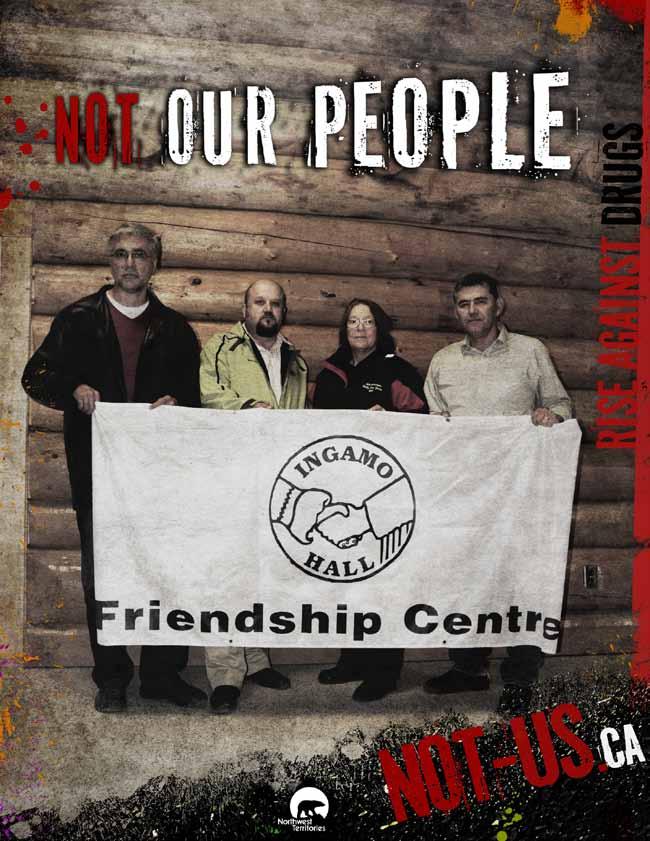
Canada Post Contract 40049465


















































 By shafia usman
georgina Jacobson Masuzumi at her home in tuktoyaktuk
PHOTO: m aung Tin
By shafia usman
georgina Jacobson Masuzumi at her home in tuktoyaktuk
PHOTO: m aung Tin














 PHOTO: S H afia uS man
PHOTO: S H afia uS man

 By Shafia u sman
By Shafia u sman








 PHOTO: m aung Tin
PHOTO: m aung Tin























 novice division players at the opening ceremony
novice division champions. Dylan Doornbos, kyra McDonald, Leesha Setzer, kierra McDonald, Steven Pope, ty norris, kieron Clement.
PeeWee Division Champions. Corey Cockney, Jesse elias, Cole Felix, Donald kuptana, Larson nasogaluak, Jaimison Wright, Jimmy Stewart Jr., Davina McLeod with coach Pat kuptana
gwich'in Cup tournament 2011
novice division players at the opening ceremony
novice division champions. Dylan Doornbos, kyra McDonald, Leesha Setzer, kierra McDonald, Steven Pope, ty norris, kieron Clement.
PeeWee Division Champions. Corey Cockney, Jesse elias, Cole Felix, Donald kuptana, Larson nasogaluak, Jaimison Wright, Jimmy Stewart Jr., Davina McLeod with coach Pat kuptana
gwich'in Cup tournament 2011

 By k aren Cornelius
By k aren Cornelius










 Mable nigiyok
Printmaker Louie nigiyok
Mable nigiyok
Printmaker Louie nigiyok











 Makayla kikoak
Left to right: Shaquella kaglik, kiersten rogers, katelynn Crocker, Maya krizan, Ally engram
Left to r ight: Myja Semmler, Makayla k ikoak, Paris Wainman, Destiny Pokiak
Makayla kikoak
Left to right: Shaquella kaglik, kiersten rogers, katelynn Crocker, Maya krizan, Ally engram
Left to r ight: Myja Semmler, Makayla k ikoak, Paris Wainman, Destiny Pokiak




